Aperture's Blog, page 115
June 22, 2017
A Short History of the African Photobook
For Bronwyn Law-Viljoen, publisher of Fourthwall Books, the photobook is a space for political and social history.
By Brendan Wattenberg

Joana Choumali, Mr Yembila, 43, security guard, Môssi, Burkina Faso, from the series Hââbré: The Last Generation, 2014–16
Courtesy the artist and Fourthwall Books
One balmy night last November, a bus arrived at 44 Stanley, a shopping center in Johannesburg, and out poured a throng of artists, photographers, and writers to attend a party at the pop-up shop for Fourthwall Books. Bronwyn Law-Viljoen, who together with Oliver Barstow founded Fourthwall in 2010, hosted the gathering on the occasion of Black Portraiture[s], the roving biannual conference on African and African American art that was then taking place at Johannesburg’s Turbine Hall. Fourthwall is known for intelligent, sometimes experimental books by African artists in which the texts are a crucial element. (Law-Viljoen—who grew up in Johannesburg, studied literature at New York University, and was once a work scholar at Aperture Foundation—recently published her first novel.)
Like any photobook publisher, Fourthwall is fueled by a sharp sense of idealism. The night after the Fourthwall party at 44 Stanley, Law-Viljoen spoke at Black Portraiture[s] about the history of the photobook in South Africa—a history to which she is now contributing through her titles and also the Fourthwall Books Photobook Award, inaugurated in 2016. But she opened her remarks by recognizing the community of photobook enthusiasts who had found their way to Fourthwall. “Sometimes you feel like you’re working all alone,” she said. “But last night, I felt as though people appreciate our work. They understand what we’re trying to do. And that was gratifying.”

Spread from House of Bondage (Random House, 1967). Photographs by Ernest Cole
Brendan Wattenberg: In addition to being a publisher, you’re also a writer and a scholar. So, let’s start with a history lesson: what have been the most influential photobooks in South Africa? How have South African photobooks contributed to visual culture in Africa at large?
Bronwyn Law-Viljoen: If we’re talking about the period before the end of apartheid in 1994, then these are some of the most influential photobooks in South Africa: Ernest Cole’s House of Bondage [Random House, 1967]; David Goldblatt’s On the Mines [with Nadine Gordimer, Struik, 1973]; George Hallett’s Present Lives, Future Becoming [with Cosmo Pieterse, Hickey Press, 1973] and Images [BLAC Publ. Houses, 1979]; Peter Magubane’s Black as I Am [with Zindzi Mandela, Guild of Tutors Press, 1978]; and Roger Ballen’s Platteland [Quartet Books, 1994]. Since 1994, there have been books by Santu Mofokeng, Jo Ractliffe, Guy Tillim, Mikhael Subotzky, Sabelo Mlangeni, Pieter Hugo, Zanele Muholi, and others that occupy a very important place in contemporary South African photography.
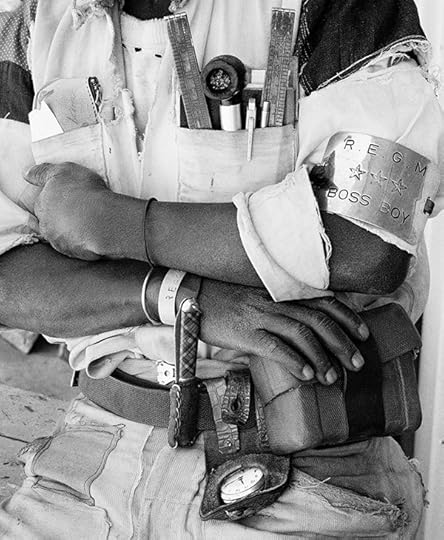
David Goldblatt, Boss Boy, Battery Reef, Randfontein Estates, Randfontein, 1966, from the book On the Mines (Steidl, 2012)
© the artist and courtesy Steidl
Wattenberg: Santu Mofokeng’s The Black Photo Album/Look at Me: 1890–1950 [Steidl, 2013] and Guy Tillim’s Joburg: Points of View [Punctum, 2014] and Petros Village [Punctum, 2006] are almost like novels or concept books—they’re keys to unlocking a larger body of work. But younger artists have also used the photobook to communicate urgent social issues, such as prison conditions in Mikhael Subotzky’s Beaufort West [Chris Boot Ltd., 2008], and the stories of LGBTQ individuals in Zanele Muholi’s two books from her series Faces and Phases [Prestel, 2010 and Steidl and the Walther Collection, 2014] and Sabelo Mlangeni’s Country Girls [Stevenson Gallery, 2010].
Law-Viljoen: There is a very clear sense of history in all of the photographers you mention, and not just political history, but also photographic history. They have inherited a political and historical narrative, as well as the desire to tell “stories”—not only about the past, but also about prevailing conditions of inequality, poverty, and the long reach of apartheid. But at the same time, these photographers have broken with the forms that those narratives have taken.
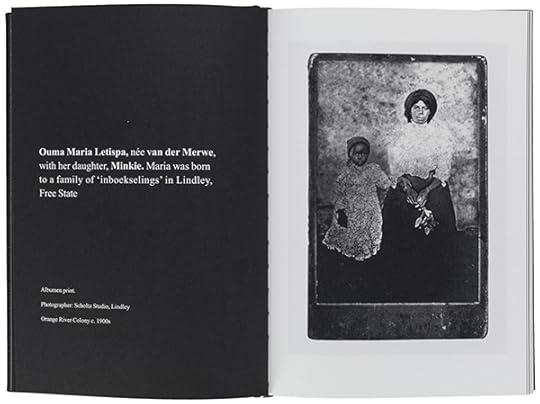
Spread from Santu Mofokeng’s The Black Photo Album: Look at Me: 1890–1950 (Steidl/The Walther Collection, 2013)
Courtesy The Walther Collection
Santu Mofokeng, for example, in The Black Photo Album, is really the first photographer in South Africa to have turned his attention to the “found photograph” as having both aesthetic and social legitimacy. Jo Ractliffe departs radically in her early work from the tradition of landscape photography through her use of the pinhole camera. In her later books, such as As Terras do Fim do Mundo [Stevenson Gallery, 2010], she looks at landscape not as the representation of an ideal view of land, but rather as a repository of trauma and violence. In this, as well as in her rigorous attention to the facts that attach themselves to particular landscapes, Ractliffe is very similar to Goldblatt; but she departs from his influence in allowing the conceptual framework of her projects, rather than the monumental power of individual images, to dictate the shape and scope of her visual narrative.
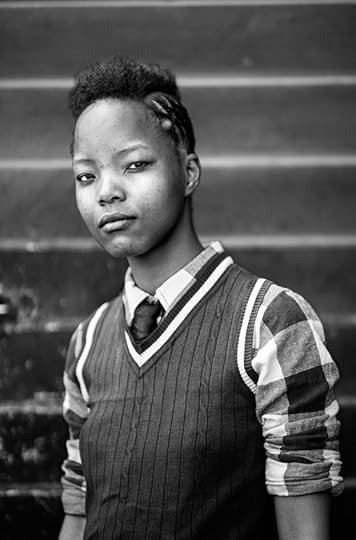
Zanele Muholi, Tumi Nkopane, KwaThema, Johannesburg, 2013, from the book Faces and Phases: 2006–2014 (Steidl/The Walther Collection, 2014)
© the artist and courtesy Stevenson, Cape Town and Johannesburg
Wattenberg: How do you see the contemporary photobook in South Africa responding to the past, but also breaking new ground in form and content?
Law-Viljoen: Muholi’s extraordinary achievement, in Faces and Phases, is her ability to represent the experience of a marginalized group of people in society while at the same time suggesting the dynamic agency of the individuals in this group. This is emblematic of a profound psycho-political shift in South African art in general since the end of apartheid. The focus for many artists and photographers is less on people as representatives of a system or group than it is on the individual, as having their own, unique experience of trauma and as agent in their own life.
For black photographers in particular, there is a need to portray black people as creators and definers of their own worlds rather than as occupants of someone else’s. The political is still present and urgent in South African photography, but the formal and philosophical terms of the representation of the political have shifted quite dramatically.
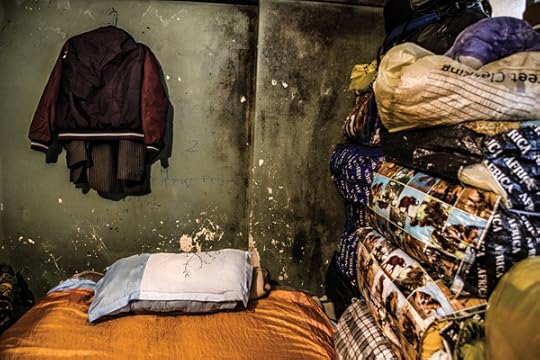
Mark Lewis and Tanya Zack, from the book Bed Room (Fourthwall Books, 2016)
Courtesy the artists and Fourthwall Books
Wattenberg: When you opened Fourthwall Books, what types of photobooks were you most interested in publishing? What makes a book a Fourthwall book?
Law-Viljoen: We were interested in beautiful and unusual books that told unusual stories and did not rely solely on the singular image, or on a series of singular images, for their impact. Rather, we wanted to make books that were able to sustain a long engagement with their subject matter—often, though not always, by combining text and image in interesting ways.
So we looked for strong writing that had “grown” alongside the images. In other words, we were not very interested in the traditional critique produced “after the fact”—a piece of writing in which the writer looks at all the photographs she or he has been sent, then writes a “response” text. We liked projects in which images and text came into the world at about the same time. And we liked less obvious connections between images and text: short stories rather than essays, or essays apparently about something other than the stuff in the photographs. We also wanted to make “slow” books, ones in which photographers looked for a long time at the same thing from a lot of different angles.

Mark Lewis and Tanya Zack, from the book Bed Room (Fourthwall Books, 2016)
Courtesy the artists and Fourthwall Books
Wattenberg: How do you choose your projects? Do you work with local designers in South Africa? And where do you print your books?
Law-Viljoen: The projects that appeal to us usually are the ones that make little business sense—hence nobody else will touch them! We’ve always done our own design. Oliver Barstow was the cofounder of Fourthwall, and he designed all the books up to 2015. Since then our designer has been Carla Saunders, and we’ve sometimes had other designers work on projects—but all have been South African. We have printed books in South Africa, China, Germany, and Italy.
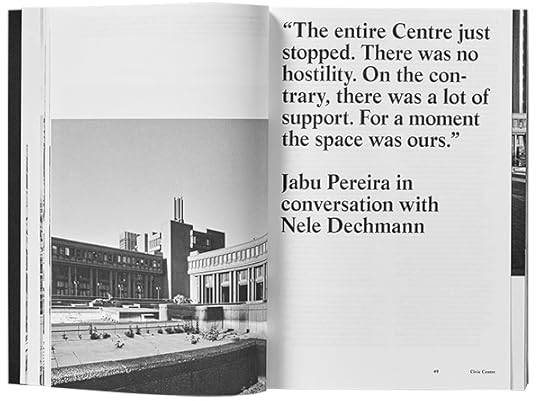
Spread from UP UP: Stories of Johannesburg’s Highrises (Fourthwall Books, 2016). Photograph by Mpho Mokgadi
Courtesy the artist and Fourthwall Books
Wattenberg: You’ve published several books about Johannesburg, including UP UP: Stories of Johannesburg’s Highrises [2016], Writing the City Into Being [2010], and Terry Kurgan’s Hotel Yeoville [2013], which seem to dissect the city, its communities, and its architecture in words and pictures. Why is Johannesburg an enduring photographic subject? What do your books—which privilege writing—offer to the ongoing portrait that artists are collectively making of Johannesburg?
Law-Viljoen: We never set out to make books about Johannesburg, but I suppose once we had made a couple, we came to be seen as the publisher of Johannesburg material. Joburg is vibrant, ugly, beautiful, violent. It has lots of hidden pockets. It’s very fragmented and divided. It’s Goldblatt’s city, it’s Mofokeng’s city, it’s Peter Magubane’s city. But it also belongs to young artists and it features in quite diff erent ways in their work. The historic and hugely important Market Photo Workshop is here—so it’s the place young photographers test their mettle. I suppose it suits us as a subject for books because it has so many stories in it, and we like stories with funny beginnings and open endings.

Cover of Lisa King’s Sometimes I make money one day of the week (Fourthwall Books, 2015)
© and courtesy the artist and Fourthwall Books
Wattenberg: Lisa King’s captivating book Sometimes I make money one day of the week [2015] is an account of the traders working at the Zimbabwe Stock Exchange. Why were you attracted to this project?
Law-Viljoen: Lisa’s book was odd—not obvious material for a photobook, or in fact for any book. She spent a number of years taking photographs in the last manual call-out stock exchange in the world, which has now been digitized. The pictures were of a bunch of very ordinary-looking people in a very ordinary, tatty room. But it was an unexpectedly interesting story. And it came with the writer Sean Christie. He had not yet written the text when we first saw the images, but we knew his work—he’s a writer who always takes the road less traveled. And both Lisa and Sean stuck with this odd little story for a long time. They were determined to show us (and readers in general) how interesting they found it. In a way it’s the perfect Fourthwall book.

Spread from Sometimes I make money one day of the week (Fourthwall Books, 2015). Photographs by Lisa King
© and courtesy the artist and Fourthwall Books
Wattenberg: One of your most recent titles is the Ivorian photographer Joana Choumali’s Hââbré, The Last Generation [2016]. How did you learn about Choumali’s work? And could you speak about the design—the minimalist approach, the typography, and the bold choice of a bright red cover?
Law-Viljoen: Joana’s book was nominated for the 2016 Fourthwall Books Photobook Award, which is the first such award on the African continent. For Hââbré, we wanted to represent Joana’s vision of her sitters as important bearers of an old tradition—facial scarification among people from Burkina Faso who have migrated to Ivory Coast. At the same time, however, we did not want to over-romanticize them. So we decided that, by placing the interview before the image, we would make the reader “listen” to the subject in the portrait before they saw them in the image. We made the text as visual as we could: a large, bold font that prefaces each pair of images. As for the cover, the red is a foil to the cool blue background that Joana used in her portraits. It’s on the other side of the spectrum to the backdrop, but both colors have a lot of black in them.
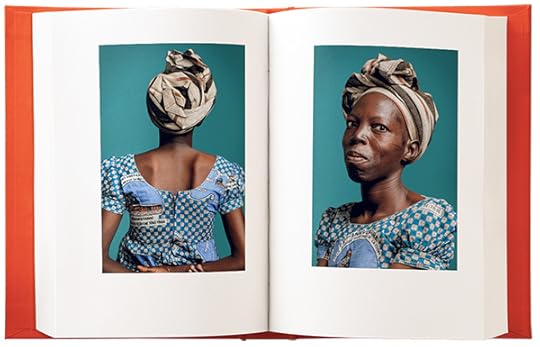
Spread from Hââbré: The Last Generation (Fourthwall Books, 2016). Photographs by Joana Choumali
Courtesy the artist and Fourthwall Books
Wattenberg: What are the challenges of publishing photobooks in South Africa? What are the rewards?
Law-Viljoen: Funding is the primary challenge. The second challenge, not unrelated to the first, is the size of the book-buying market. We have to balance our desire to make beautiful books against the realities of life for most people in South Africa. We often ask ourselves about the relevance of our books, the relationship of our books to the social world we live in. We always address ourselves to these problems in the books, but the end result is out of reach for many who might otherwise like to buy them.

Terry Kurgan, Hotel Yeoville Project, 2012, from the book Hotel Yeoville (Fourthwall Books, 2012)
© and courtesy the artist
Wattenberg: Still, by making books, you provide a measure of cultural preservation, and you also show young photographers the many ways they might communicate their ideas and vision. Do you see a growing community around photobooks in South Africa today?
Law-Viljoen: We see a greater awareness of the possibilities that a book provides for a photographer, and a growing sophistication in readers and photographers. This suggests a wider engagement with the world of books and photography outside of South Africa, which is a good thing. Perhaps we’ve also contributed to this, through the kinds of books we’ve chosen to do and the design choices we’ve made over the years.
Bronwyn Law-Viljoen is an associate professor and head of Creative Writing at the University of the Witwatersrand, Johannesburg, as well as editor and cofounder of Fourthwall Books. Her debut novel is The Printmaker (Umuzi, 2016).
Brendan Wattenberg is the managing editor of Aperture magazine.
This article, which originally appeared in The PhotoBook Review #12, Spring 2017, is produced in collaboration with Contemporary And (C&) – Platform for International Art from African Perspectives.
The post A Short History of the African Photobook appeared first on Aperture Foundation NY.
9 Publications that Illuminate Queer Life
Pride was born of protest. What began as a commemoration of the 1969 Stonewall Riots has grown into a month dedicated to recognizing and celebrating the impact that lesbian, gay, bisexual, and transgender individuals have had on history and culture. Photographs continue to be instrumental in reflecting and shaping representations of LGBTQ communities. This month, Aperture highlights nine photobooks that radically reimagine queer visibility.


Aperture, Issue 218, “Queer”
“Queer doesn’t have a look, a size, a sex,” Vince Aletti writes. “Queer resists boundaries and refuses to be narrowly defines.” Over the past three decades, the public conversation about what it means to be queer has evolved, and remains not only relevant, but also necessary to continue. With work by photographers such as Zanele Muholi, Ren Hang, and Catherine Opie, Aperture’s “Queer” issue is an essential primer on the ways in which images have shaped that conversation.


Ren Hang, Untitled, 2013–14
Courtesy the artist


Zanele Muholi, Zukiswa Gaca, Grand Parade, Cape Town, 2011
Courtesy Yancey Richardson Gallery, New York

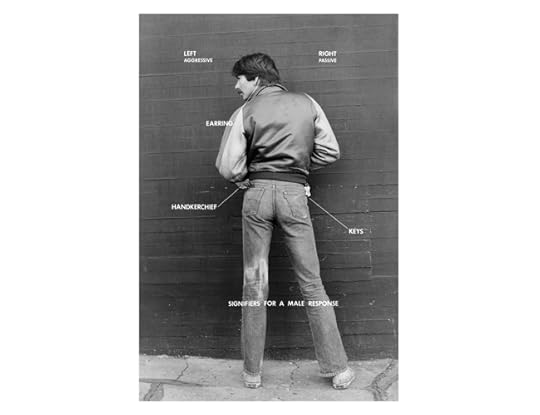
Hal Fischer, from Gay Semiotics, 1977
© and courtesy Hal Fischer, and Cherry and Martin, Los Angeles

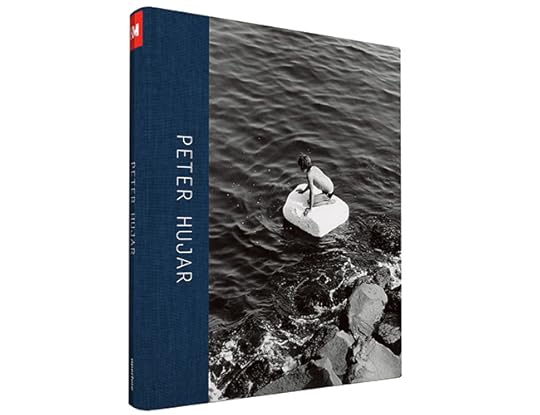
Peter Hujar: Speed of Life
Peter Hujar died of AIDS in 1987, leaving behind a complex and profound body of photographs. Underappreciated during his lifetime, Hujar was a leading figure in the cultural scene in downtown New York in the 1970s and ’80s, an inspiration to legendary photographers Robert Mapplethorpe and Nan Goldin. Among his subjects are visionaries such as Susan Sontag, William S. Burroughs, and Andy Warhol. “In many ways Peter Hujar defined downtown for me,” wrote photography critic Vince Aletti. “He went places I never dared to, and hung out with people I’d only read about.”

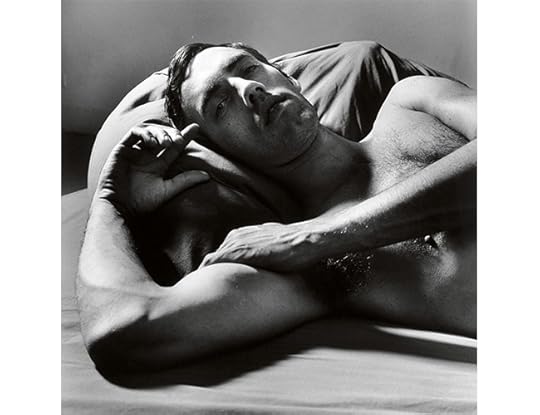
Peter Hujar, David Wojnarowcz Reclining (2), 1981
© The Peter Hujar Archive, LLC. Courtesy Pace/MacGill Gallery, New York, and Fraenkel Gallery, San Francisco

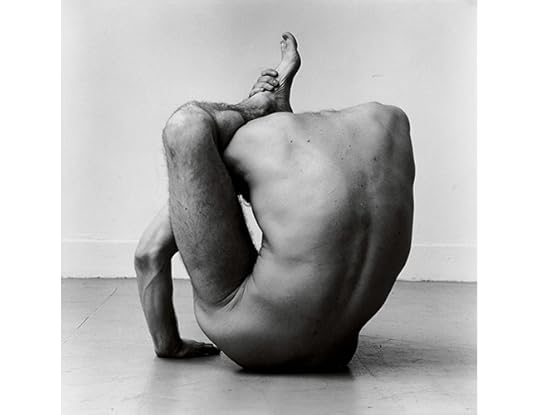
Peter Hujar, Gary in Contortion (1), 1979
© The Peter Hujar Archive, LLC. Courtesy Pace/MacGill Gallery, New York, and Fraenkel Gallery, San Francisco

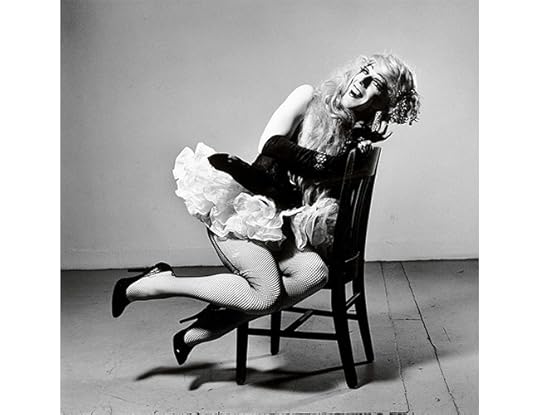
Peter Hujar, Ethyl Eichelberger as Minnie the Maid, 1981
© The Peter Hujar Archive, LLC. Courtesy Pace/MacGill Gallery, New York, and Fraenkel Gallery, San Francisco


Muse: Mickalene Thomas Photographs
Mickalene Thomas draws on cultural icons and her relationships with lovers and family alike to subvert the male gaze and assert new definitions of beauty. Thomas, who spent several years estranged from her mother before telling her she was a lesbian, has said of their collaboration, “Using my mother as a model has allowed us time to establish this nice relationship, for me to get to know her,” she said. “I feel it’s a way of making her happy.” Muse gathers together her various approaches to photography in a courageous exploration of gender and sexuality.


Mickalene Thomas, Remember Me, 2006
© the artist


Mickalene Thomas, A Moment’s Pleasure #2, 2007
© the artist


Mickalene Thomas, I’ve Been Good to Me, 2011
© the artist

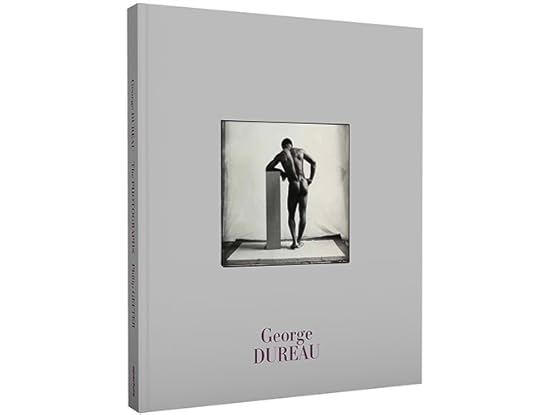
George Dureau: The Photographs
Born in New Orleans in 1930, George Dureau started taking pictures for the pleasure of photographing his lovers, and as research material for his paintings. Only later on did he begin to take his photographs seriously as works of art in their own right. Dureau is known for his tender, homoerotic approach to his subjects, among them hustlers, amputees, dwarves, and drifters. Compared to Robert Mapplethorpe’s work, Dureau’s photographs distinguish themselves by the intimate connection between photographer and subject. “My models are people who are beautiful and sexy and the fact that there’s a stump where an arm or a leg should be doesn’t mar their sexiness or their beauty,” Dureau said in a 2005 interview. “You don’t say, ‘Well, let’s throw out this little Roman sculpture because it’s partly broken.’”


George Dureau, Roosevelt Singleton, 1974
© the artist, courtesy Arthur Roger Gallery and Higher Pictures


George Dureau, Fred Temnel, 1976
© the artist, courtesy Arthur Roger Gallery and Higher Pictures


George Dureau, Earl Leavell, 1977
© the artist, courtesy Arthur Roger Gallery and Higher Pictures


The Ballad of Sexual Dependency by Nan Goldin
Nan Goldin’s iconic visual diary chronicles the struggle for intimacy and understanding between her friends, family, and lovers in the 1970s and ’80s. Her work describes a world that is visceral, charged, and seething with life. What’s more, Goldin's work challenged censorship, disrupted gender stereotypes, and brought crucial visibility and awareness to the AIDS crisis. Goldin herself has said “I’m bisexual so I can’t really come out as gay. When I’m gay, I’m very gay. And when I’m with men then, you know, I’m with men. I don’t fall in love with people because of their gender.”


Nan Goldin, Trixie on the cot, New York City, 1979
© the artist

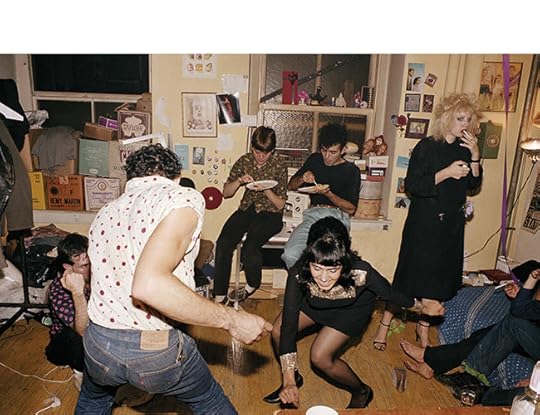
Nan Goldin, Twisting at my birthday party, New York City, 1980
© the artist


Brush Fires in the Social Landscape by David Wojnarowicz
Throughout his career, David Wojnarowicz’s use of photography was extraordinary, as was his unprecedented ways of addressing the AIDS crisis and issues of censorship, homophobia, and narrative. Brush Fires in the Social Landscape, begun in collaboration with the artist before his death in 1992, explores Wojnarowicz’s profound legacy through the lens of his friends and community, among them Nan Goldin and Kiki Smith.


David Wojnarowicz, Seeds of Industry II, 1988-89
© the Estate of David Wojnarowicz, Courtesy P.P.O.W Gallery, New York


David Wojnarowicz, Untitled (face in dirt), 1990
© the Estate of David Wojnarowicz, Courtesy P.P.O.W Gallery, New York

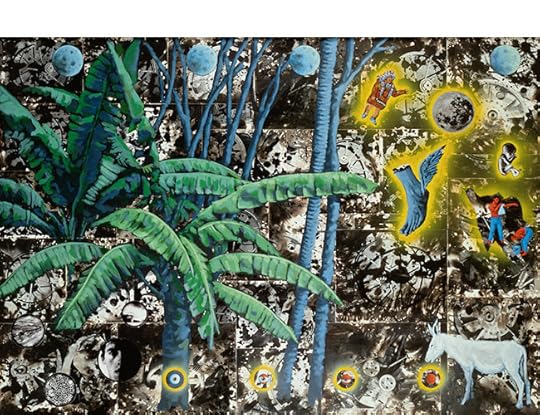
David Wojnarowicz, Where I’ll Go After I’m Gone, 1988-89
© the Estate of David Wojnarowicz, Courtesy P.P.O.W Gallery, New York


Manhattan Sunday by Richard Renaldi
As a young man who had recently embraced his gay identity, Richard Renaldi found a home in “the mystery and abandonment of the club, the nightscape, and then finally daybreak, each offering a transformation of Manhattan from the known world into a dreamscape of characters acting out their fantasies on a grand stage.” In Manhattan Sunday, Renaldi captures that ethereal moment when Saturday night blurs into Sunday morning in Manhattan, and evokes the vibrant nighttime rhythms of the city.


Richard Renaldi, from Manhattan Sunday
© the artist


Richard Renaldi, from Manhattan Sunday
© the artist


Richard Renaldi, from Manhattan Sunday
© the artist


Paz Errázuriz: Survey
Chilean photographer Paz Errázuriz is known for spending months or years within a given community, building trust and carefully studying social structures, among them brothels, shelters, psychiatric wards, and boxing clubs, where women were prohibited. In the 1980s, during the dictatorship of General Augusto Pinochet, Errázuriz took took pictures of trans prostitutes working in clandestine brothels in Santiago and Talca. “The resulting series, La manzana de Adán (Adam’s apple, 1982–87), shows the intimacies fostered by queer men and trans women in the chosen families formed within brothels,” Julia Bryan-Wilson writes. “Decades before the rise of the phrase trans feminism and the increased mainstreaming of (some) trans bodies, Errázuriz’s La manzana de Adán sought to capture Chilean trans women without shame or stigma.”


Paz Errázuriz, Evelyn IV, Santiago, from the series Adam’s apple
Courtesy the artist


Paz Errázuriz, Club Buenos Aires, Santiago, from the series (In twos) Tango
Courtesy the artist


Paz Errázuriz, Boxer VI, Santiago, from the series Boxers: The fight against the angel, 1987
Courtesy the artist

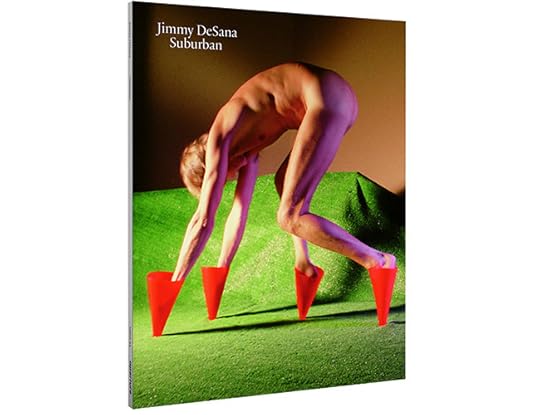
Suburban by Jimmy DeSana
Jimmy DeSana’s sexually charged photos of nude subjects in Suburban, unpack stereotypes and examine cultural mores. A leading figure in New York’s downtown art scene during the 1970s and ’80s, DeSana has played a key role in picturing queer identity. His surreal photographs incorporate everyday items to explore the human body as both a living and sculptural object. “I don’t really think of that work as erotic,” DeSana told Laurie Simmons, his contemporary and longtime roommate. “I think of the body almost as an object.”


Jimmy DeSana, Thimbles, 1983
© the Jimmy DeSana Estate/Salon 94


Jimmy DeSana, Storage Boxes, 1980
© the Jimmy DeSana Estate/Salon 94


Jimmy DeSana, Untitled, 1979
© the Jimmy DeSana Estate/Salon 94
The post 9 Publications that Illuminate Queer Life appeared first on Aperture Foundation NY.
In Ghana, Visions of Queer Friendship and Love
Eric Gyamfi reflects on his activism, photography, and telling the stories of West Africa’s queer communities.
By M. Neelika Jayawardane

Eric Gyamfi, Some of the LGBT community members organize a night of dance and performance for themselves after the international day against homophobia and transphobia event as a way to get to know other community members and to network. From the series Just Like Us, 2016
Courtesy the artist
In his series Just Like Us (2016), the photographer Eric Gyamfi explores the contradictions of queer life in Ghana. His work chronicles what it means to be “other” in a nation of people who have a remarkably well-defined sense of what binds them together—the geographical and legal constructs that shape their national identity as Ghanaians. Just Like Us is the beginning of an open-ended journey in which Gyamfi chronicles the lives of queer friends and acquaintances whom he calls “participants.” It’s a project that helps Ghanaians rediscover the ordinary in the face of extraordinary rumors.
Several months before I wrote an essay about Gyamfi for “Platform Africa,” the summer issue of Aperture, I was introduced to his work at the LagosPhoto Festival. Despite the bustle of the location—a large, busy hotel in the city’s Echo Atlantic development—and despite being placed in a nook among many other works, his work stood out. And just in case I didn’t notice them, the celebrated veteran photographer Akinbode Akinbiyi made sure I would. “Watch this guy!” he said, jabbing his finger at the photographs.
My first conversation with Gyamfi took place on March 6, 2017, the day marking the sixtieth anniversary of Ghana’s independence from Britain. When he answered my message on Skype, I’d just been listening to Gyamfi’s video introduction to See You See Me (2016–17), an exhibition project at the Nubuke Foundation in Accra, which was supported by the Magnum Foundation Emergency Fund. I thought, then, that I could possibly frame my Aperture essay within the context of Ghana’s Independence Day and the poetic longings for creating and being “home.” Our conversation ended at 2:59 a.m. Accra time. It was the beginning of a dialogue that helped me understand how to best introduce readers to his body of work.

Eric Gyamfi, Henry goes through some old photos. In 2011, Henry was married, and he got divorced in 2015. Henry has a son from this marriage, who is currently in the care of Henry’s mother (his son’s grandmother). From the series Just Like Us, 2016
Courtesy the artist
Neelika Jayawardane: In my introduction to your Aperture portfolio, I wrote that since the beginning of your career, you have “focused on individuals who have endured marginalization and exclusion.” You mentioned immediately that you didn’t want to be framed solely by your work about marginalized groups. Could you explain this choice?
Eric Gyamfi: Once there is a me and a you, everyone potentially carries the possibility of being an other. But marginalization is a very strong word. I do not feel comfortable being framed within that context as it really boxes me in. Some of these situations are difficult to explain but so many contradictions exist simultaneously and are real experiences. I am more interested in creating bridges across which we can experience realities other than our own, whether it be those of marginalized people or not.

Eric Gyamfi, Henry and his boyfriend, Mingle. From the series Just Like Us, 2016
Courtesy the artist
Jayawardane: As I was thinking about your work, I realized that it was important to speak about your journey as a photographer who began with explorations of the self: the memories you recreated from your childhood, positioning yourself within the re-enacted dramas of your photographs. These were the photographs, from the series Asylum, that I saw in Lagos. What was the concept behind that series?
Gyamfi: At the heart of this storytelling experience is the centrality of truth, and I am very much interested in that. When we experience the world, there is almost always a kind of filter. When we tell stories, we have to think them through. What, then, is the truth in storytelling? We say, to the storyteller, tell me what happened, tell me the story. My own memories become the starting point for interrogating this idea of the truth. Through the re-enactment process, derivative truths are created that otherwise didn’t exist, and older memories are added; I’m playing on recall, and attempting to make them true somehow in the present between shutter clicks. This exercise is also very revealing, healing even. Like being your own psychotherapist.
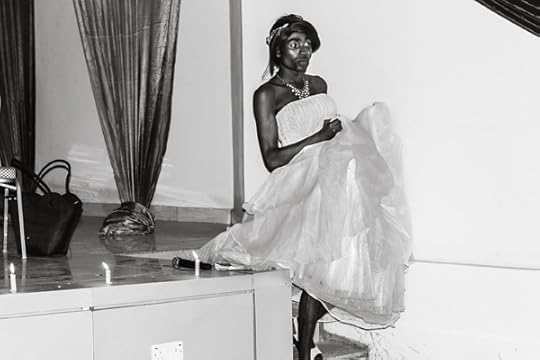
Eric Gyamfi, Henry performing in drag. From the series Just Like Us, 2016
Courtesy the artist
Jayawardane: You prefer to use the term queer rather than LGBTQ, as is commonly used in the U.S. In the pages of an international magazine like Aperture, you understood the importance of translating the ideas of Just Like Us for a global audience, but the nuances of terminology are important to you.
Gyamfi: Yes, I have been using queer as a more inclusive term, as opposed to LGBTQ, as I feel queer has the potential to embrace people with varying sexualities, and those who wouldn’t want to fit into a neat lesbian or gay box. But I guess that’s what the “Q” at the end of LGBTQ stands for—questioning. Words and labels come with their own baggage, their own of history and visual representations, and until I can properly understand and situate them, I do not feel comfortable using them.
I heard the word gay for the first time when I was in my second year of junior high school. I was twelve at the time. I remember that day very well. Fredrick, my dorm mate then, was the one who passed on this information. He said, “Abroad, men who like other men are called gay.” I understood what he meant, literally, and could connect to it. I started looking up the word on the Internet. I think that sometimes when people say that being gay is “un-African,” it is probably just the label they are referring to. Because the term has its own histories and imagery in Ghana that people may not readily relate to—or that people here feel is foreign.
So, I wanted to find out how queer people are referred to in our individual local dialects and what kinds of imagery accompany these labels. Until I heard the word gay for the first time, how did I imagine queer people? In instances where there are no labels, can we find out why? Queer—as a label—is not entirely free of these problematics. Some of my friends say that queer is cowardly and only people ashamed of their sexuality use it.
I also feel that refusing to readily define people, or putting them into these neat categories can form a part of the solution here. You would be surprised at the kinds of relationships that exist that people do not name. It has been a part of the culture to let certain things be without labelling them. And, I dare to say, that strict labels and categories of gay, lesbian, bisexual, et cetera, have also been tools used for widespread homophobia here. Of course, queer is a label, too. But it is one that I feel has the capacity to be everything and nothing.

Eric Gyamfi, Kwasi and Annertey find the Akaa Falls. Kwasi, looking to start a magazine on Ghanaian tourism, explores the eastern regional landscape of Ghana with his friend, Annertey, for new places to feature in the debut issue of his magazine. Kwasi identifies as a gay man, Annertey as a straight man. From the series Just Like Us, 2016
Courtesy the artist
Jayawardane: A lot of research—meaning personal contact with the people you photograph and learning their daily routines—goes into your work. Why is this process important?
Gyamfi: I am very much interested in understanding people’s experiences; their sexualities are just one aspect of their lives. My curiosity lies predominantly in why people have the experiences they have and how different mine would be if I were to grow up under similar situations and conditioning. My approach, therefore, is to be with people, to experience life with them. It’s how I experience life for myself, too. In some instances, my work can be more about understanding myself.

Eric Gyamfi, “Someday, soon, I’d have to live as a straight man,” Jay laments, one Thursday afternoon after school as we walked. “I think about that every day.” Jay identifies as a gay man. From the series Just Like Us, 2016
Courtesy the artist
Jayawardane: Eric, on many occasions that I’ve emailed you, you are preparing to go to or are returning from a photography trip, sometimes traveling great distances. Like Zanele Muholi, you are deeply involved in your queer community; you’re an intrinsic part of this community’s well-being, be they inhabitants of the city or of rural areas.
Gyamfi: I have been interested in learning and documenting what it means to be queer here and now, and the only way to do that, for me, is by being present. I have been thinking about how active we are as participants in helping write history, and what better way to do that than by contributing our lives, in visuals and literature, to the larger overall history of this place.
Neelika Jayawardane is Associate Professor of English at the State University of New York–Oswego and arts contributor to Al Jazeera English.
This article is part of a series produced in collaboration with Contemporary And (C&) – Platform for International Art from African Perspectives. Selected prints by Eric Gyamfi are available from Aperture Foundation.
Read more from Aperture Issue 227, “Platform Africa,” or subscribe to Aperture and never miss an issue.
The post In Ghana, Visions of Queer Friendship and Love appeared first on Aperture Foundation NY.
June 21, 2017
Learning From Addis Ababa
Aida Muluneh, founder of the Addis Foto Fest, speaks about how education plays a central role in connecting African photographers.
By Brendan Wattenberg
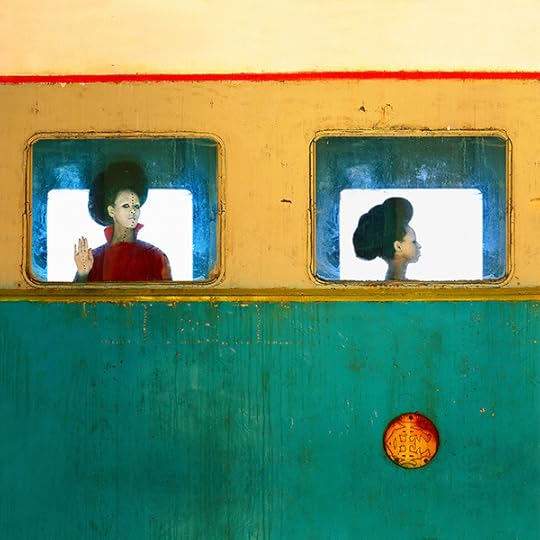
Aida Muluneh, Departure, 2016
Courtesy the artist and David Krut Projects
When Aida Muluneh started the Addis Foto Fest in 2010, she had a vision. “I didn’t want to do an ‘African’ festival,” she told me earlier this year. “The important thing is cultural exchange through images.” Born in Ethiopia, Muluneh was raised in Yemen and Canada. She attended Howard University in Washington, D.C., worked as a photojournalist for The Washington Post, and pursued fine art photography. Back in Addis she established the arts consulting firm DESTA for Africa (DFA) to support the festival and initiated ambitious educational workshops for local photographers. Her festival has a considerable international scope. In 2016, it welcomed 126 photographers from forty countries and urged all of them to seek or provide mentorship and to find new audiences for their work.
Brendan Wattenberg: Education is integral to your work in Ethiopia with DFA and the Addis Foto Fest. You’ve said that your own photographic education began when you were a teenager. What were the experiences that made you want to learn about photography?
Aida Muluneh: In high school, in Calgary, we had an art department and a darkroom that no one was really using. A group of us, I think four students, asked if we could use it. When I saw my first print, I became obsessed with that.
Wattenberg: Do you remember the picture?
Muluneh: Of course. It was a blooming flower! In black and white.
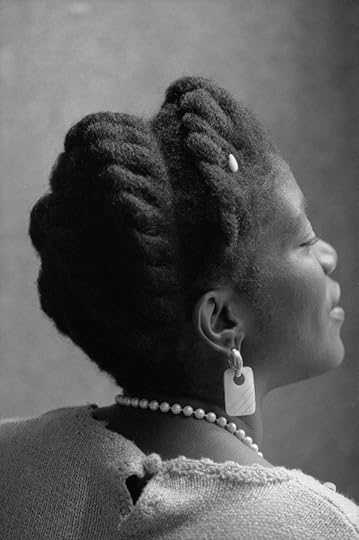
Chester Higgins Jr, A Brooklyn Woman, New York City, 1989, from Feeling the Spirit: Searching the World for the People of Africa (1994)
© and courtesy the artist
Wattenberg: Did you do a history of photography course in high school?
Muluneh: We didn’t do any of that. Basically, we learned how to use a camera, and then we’d go out and shoot. The idea was just to get the feel of the darkroom process. But I don’t think our teacher realized the impact it would have and the gift he gave me of seeing an image come to life on paper.
Wattenberg: At the time, were you looking at newsmagazines or photo books?
Muluneh: My mother used to buy me different kinds of books and publications, so photos were something I was always interested in. When I realized the process of printing a photo, that’s when it all came together. I did shoot here and there, but I didn’t take things too seriously until I saw Chester Higgins Jr.’s photographs at Howard.
I’ve always been interested in black-and-white photography. When I was in the States, I used to go to bookstores and look at books by photographers like Richard Avedon. But it was seeing Chester’s book, the caliber of his work, and eventually meeting him, that made a difference for me. Gordon Parks also played a role. He was not only a photographer. He was a Renaissance man.
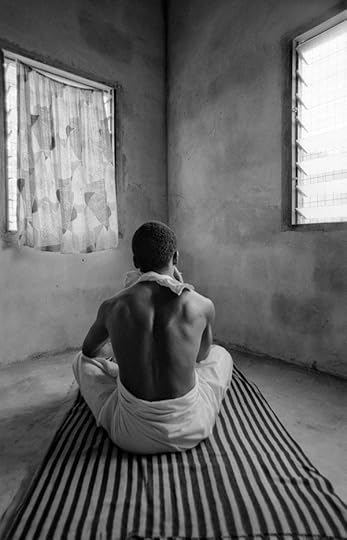
Chester Higgins Jr, Kweku meditating at home, Dzodze, Ghana, 1973, from Feeling the Spirit: Searching the World for the People of Africa (1994)
© and courtesy the artist
Wattenberg: Did you discover Chester Higgins Jr. on your own or through a professor?
Muluneh: On my own. I remember I was in the library, and there was one book of his, Feeling the Spirit (1994). My whole thing, ever since I picked up a camera, has been trying to address misrepresentation. And here was a photographer who addressed that beautifully in a collection of images.
Wattenberg: When you were studying at Howard, and later when you were working as a photojournalist, were you ever a collector of photo books?
Muluneh: At that time, I couldn’t afford many of the books. So most of my time was spent between the library and the bookstore. In the bookstore, you obviously don’t see a lot on Africa—outside of anthropological or National Geographic kinds of sentiments. That’s why Chester’s book spoke to me: he photographed across Africa, and he has done extensive work in Ethiopia. Otherwise, my mentors are predominantly African American photographers.
Wattenberg: Such as?
Muluneh: Dudley Brooks was a longtime mentor. He played a big role in my journalistic life—he’s the one who got me a job at The Washington Post. I have a great deal of admiration for Stanley Greene and his way of working. And there was a commercial photographer named Harley Little, who I interned with from 1996–98 in Washington, D.C.
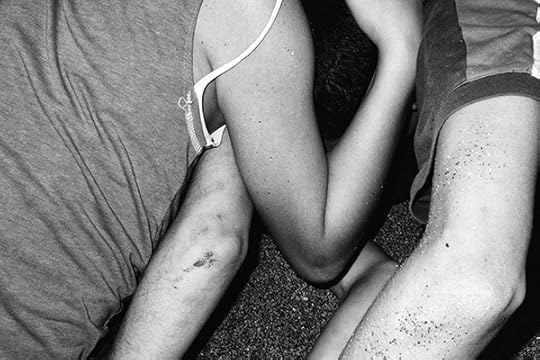
Abdo Shanan, Untitled (Algiers), from the series Diary: Exile, 2014–16. Shanan’s work was featured in the 2016 Addis Foto Fest
Courtesy the artist and Collective 220
Wattenberg: You participated in the Bamako Biennale in 2007, and that’s when you had the idea to start the Addis Foto Fest. Was education part of your concept for the festival from the beginning?
Muluneh: Yes, of course. The festival is not just for photographers; it’s for the general public to learn about photography in its different forms. A lot of my educational sentiments come from the mentors that I’ve had, who have gone out of their way to teach me. So I thought it was only right that I teach others what I’ve learned so far.
Wattenberg: When you started AFF, what kind of educational opportunities were available for photographers in Addis?
Muluneh: I returned to Addis in 2007. I started giving small workshops in Addis Ababa University School of Fine Art and Design because I realized that there were a lot of young people who wanted to learn photography, who were passionate about it, but they weren’t able to learn it in a proper way. For example, there are two commercial schools here, but all they’re teaching is wedding and studio photography. Nothing against that—it earns you money—but one of the things that we teach students is that it’s their responsibility to be the witnesses of the changing face of Ethiopia. They have to engage with it, and share their perspectives with the world. It’s not just about the commercial benefits. Most of the good photographers in Addis have come through our system in one form or another. We’re the first ones in that sense to open their minds. With photography, it’s not just the technical; it’s showing them how to tell a story that they feel passionate about.

Sarah Waiswa, Seeing But Not Seen, 2016, from the series Stranger in a Familiar Land. Waiswa’s work was featured in the 2016 Addis Foto Fest
Courtesy the artist
Wattenberg: How do you teach at DFA, besides the technical aspect?
Muluneh: A lot of our teaching is pulling images from online, putting together presentations. I want students to look at photographers from the continent. It’s not just about European or American photographers; they first have to learn who’s here on the ground and to see what other countries are producing. Often when I go to different festivals, I take photos of the exhibitions, and I introduce these in the presentation. And then the students are able to follow the photographers on Instagram and create networks.
Wattenberg: One of the other initiatives with DFA is to bring in photographers for master classes.
Muluneh: Exactly. There’s a Kenyan studio photographer named Osborne Macharia who we’ve invited to Addis twice. When he came to speak about lighting, basically the whole landscape of photography here changed, just from those four days of classes. I follow a lot of the students on social media, and I see how their work changes.
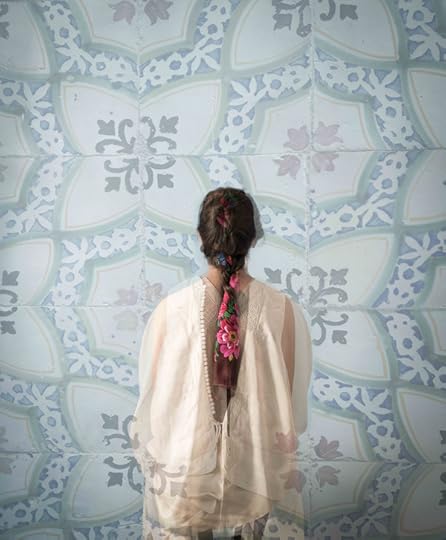
Héla Ammar, Hidden portrait IV, 2014. Ammar’s work was featured in the 2016 Addis Foto Fest
Courtesy the artist
Wattenberg: Looking ahead to the next edition of Addis Foto Fest, in 2018, how do you see education shaping your activities in the off year?
Muluneh: A lot of the education comes from having partnerships with photographers in Africa and those in other parts of the world who understand our long-term goals and objectives. We can only do the workshops when we have access to photographers who are willing to do it for free, or when we’re able to find a budget. We’re thinking about how we can build a school that will make financial sense so that we’re not always dependent on outside funding for all our activities.
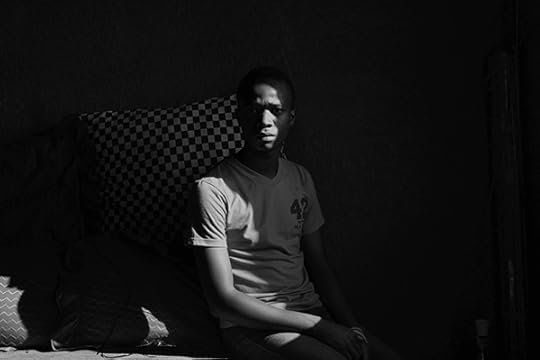
Tshepiso Mazibuko, Kamohelo, Thokoza, 2015, from the series Encounters. Mazibuko is the winner of the 2016 Addis Foto Fest Award
Courtesy the artist
Wattenberg: There’s also an educational component with the portfolio reviews for young photographers and the Addis Foto Fest Award, which began last year.
Muluneh: We’ve had the portfolio reviews since 2010, so that’s an integral part of the festival. Through the reviews, we’re getting feedback from the global photography community on where exactly the photographers are. This is essential. The photographers here need to be able to compete globally.
Brendan Wattenberg is the managing editor of Aperture magazine.
This article is part of a series produced in collaboration with Contemporary And (C&) – Platform for International Art from African Perspectives.
Read more from Aperture Issue 227, “Platform Africa,” or subscribe to Aperture and never miss an issue.
The post Learning From Addis Ababa appeared first on Aperture Foundation NY.
June 20, 2017
You Must Live and Look
In an interview from 1973, Henri Cartier-Bresson spoke frankly about the early days of Magnum. Drawn from Aperture’s forthcoming Henri Cartier-Bresson: Interviews and Conversations, 1951–1998, this conversation with Sheila Turner-Seed is a rare account of the photographer’s process.

Henri Cartier-Bresson, Easter Sunday, Harlem, New York, 1947
© the artist/Magnum Photos
Sheila Turner-Seed: Do you think you see more now than you saw when you started photography at twenty?
Henri Cartier-Bresson: I see different things, I presume. But not more, not less. The best pictures in The Decisive Moment were taken right away, after two weeks. [ . . . ] That’s why teaching and learning don’t make sense. You must live and look. All these photography schools are a gimmick. What are they teaching? Could you teach me how to walk?
These schools are phony. And it affects the way you work. To work with people is different. That’s why I liked it so much when we started Magnum, our photographers’ cooperative agency. We were working together and criticizing and going at the same speed, some quicker, some more slowly.
Turner-Seed: But do you think that a photographer’s art can grow and mature?
Cartier-Bresson: Mature? What does that mean? It’s always about reexamining, trying to be more lucid and freer, and go deeper and deeper. I don’t know if photography is an art or not. I see children painting beautifully and then at puberty sometimes a curtain drops. And then it takes a lifetime to get back—not the purity of a child, because you never get it back, once there is knowledge—but to get back the qualities of a young child.
Turner-Seed: Josef Breitenbach, the photographer and teacher, once told me that he felt most good photographers were good from the beginning and growth was an absurd concept.
Cartier-Bresson: I agree. Either you have a gift or you don’t. If you do, it’s a responsibility. You must work at it.
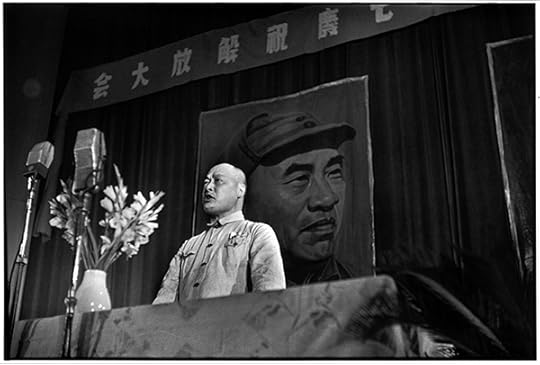
Henri Cartier-Bresson, General Chen-yi, Shanghai, 1949
© the artist/Magnum Photos
Turner-Seed: What made you decide to work in places like China and India?
Cartier-Bresson: I think every place is interesting, even your own room. But at the same time you can’t photograph everything you see. In some places the pulse beats stronger than in others. After World War II, I had a feeling, with Bob Capa and Chim [David Seymour], that going to colonial countries was important. What changes were going to take place there? That’s why I spent three years in the Far East. It was to be present when a situation was pregnant, when there was the most tension. When we started our picture agency, Magnum, in 1946 [sic : 1947], the world had been divided by war and there was great curiosity from each country to know what the other looked like. People couldn’t travel, and for us it was such a challenge to go and testify: “I have seen this and I have seen that.” There was a market. We didn’t have to do industrial accounts and all that.
Magnum is the fruit of Capa’s genius: he was very creative. He played the horses to pay for our secretaries in the beginning. Once I came back from the Far East and asked Capa for my money. He said: “Better take your camera and go to work. I had to use your money because we were almost bankrupt.” I almost got angry, but he was right. He gave me no specific ideas for shooting, but ten ideas of where to go.
Out of these ten, five or six places were very bad, two were excellent and one, fantastic! And it was like that. I kept on working.
Nowadays, working has become very difficult. There are hardly any magazines, and no big magazine is going to send you to a country because everyone has already been there. It’s another world. But there are heaps of specialized magazines that are going to use your archives. And you can make quite a decent living just with those. But it means you have to build these archives for years. It is a problem for young photographers who are just starting now.

Henri Cartier-Bresson, Independence, Jakarta, Indonesia, 1949
© the artist/Magnum Photos
Turner-Seed: Do you know what you want to do next?
Cartier-Bresson: This afternoon I would like to draw. I would like to draw much more peacefully and I would like to see other photographers. It depends. I never plan anything. You see, I feel lonely in a way. I mustn’t be nostalgic, because, I mean, it was not easy between Capa, Chim, and me. We were utterly different. We didn’t read the same books. Capa was staying up at night and I had to wake him up at ten in the morning. He was borrowing my money without telling me, these kinds of things. But there was a fundamental unity between us three. Capa was an optimist, Chim a pessimist. Chim was like a chess player or a mathematician. I was impulsive.
Turner-Seed: One gets the feeling that you miss them tremendously.
Cartier-Bresson: Well, it’s rather strange. I still don’t realize that Capa and Chim are dead. Because in this profession we are gone for a year or two and we don’t see each other. I understood that Capa was dead when [ten years later] I saw the book Images of War. Before that he was not dead at all, just someone I had not seen for some time.
There were not many photographers in Paris in the early 1930s. We drank our cafés crèmes at Le Dome in Montparnasse. I was painting in that neighborhood, which was very lively before the war.
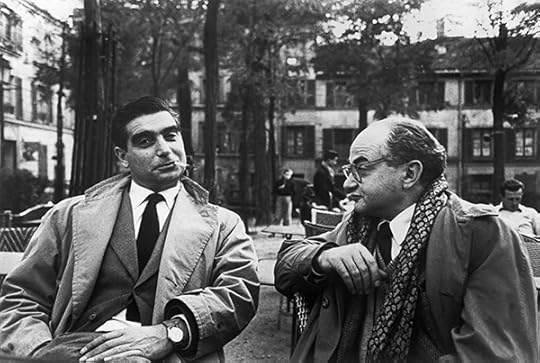
Henri Cartier-Bresson, Robert Capa and David Seymour, Place du Tertre, Paris, 1952
© the artist/Magnum Photos
Turner-Seed: Did your friendship with Capa and Chim influence your decision to abandon painting in favor of photography?
Cartier-Bresson: Not at all. We never talked about photography. We talked about life. We were thinking about where to go, and sometimes going together. There wasn’t all that silly talk about photography like now. I never dreamt of talking about all these things. It was only much later, in the 1950s, when we were doing The Decisive Moment as a coproduction between Tériade, the great art publisher in France [at Verve], and Simon and Schuster in the United States. Dick Simon came to Europe and said: “We also need a text. And the text should be a ‘how to.’ ” I didn’t insult him, but I got so red in the face that everybody was embarrassed. And I said: “ ‘How to’—no way!” I got furious and was ready to drop the whole project. And Tériade, putting on his beautiful Greek smile, said: “Well, why don’t you tell why you have been photographing for years and years? What does it all mean for you?” And I said: “Why am I clicking away like this? I don’t know.” “Well, try and find out,” Tériade said. “Marguerite Lang, my collaborator, is going to write down what you say, and then we’ll see.” And then I added: “It’s always good to clarify one’s thinking.” And I put it down practically as it is in the book. We just corrected the French because speaking and writing are not the same thing. Marguerite was telling me: “What do you mean, exactly?” She was pushing me to review my thinking, which is an extremely good exercise. But one should not be talking too much about one’s work. Otherwise one becomes an art critic.
Turner-Seed: What exactly do you mean by The Decisive Moment, the [American] title of Images à la sauvette?
Cartier-Bresson: You want to know more about the title? Well, I had nothing to do with it. I found a line in the memoirs of Cardinal de Retz, in which he said: “There is nothing in this world which does not have a decisive moment.” I used the quote [as an inscription] in the French edition, and when we were thinking of titles [for the American edition], we had a whole page of possibilities. Suddenly, Dick Simon said: “Why not use ‘the decisive moment’?” It worked well, and so I became what’s known as a plagiarist.

Henri Cartier-Bresson, Ezra Pound, 1971
© the artist/Magnum Photos
Turner-Seed: Are you able to define the moment when you press the button?
Cartier-Bresson: Oh, yes. It’s a question of concentration. Concentrate, think, watch, look, and hop, like this, you are ready. But you never know the apex of an event [before it happens]. So you’re shooting, you say to yourself: “Yes, yes, maybe, yes.” But you should never overshoot. It’s like overeating or drinking too much. You have to eat, you have to drink, but too much is too much. Because by the time you press the shutter, and you are ready to shoot once more, maybe you have lost the picture that was in-between.
The difference between a good picture and a mediocre picture is a question of millimeters, a tiny difference. But it’s essential. I don’t think there’s so much difference between photographers, but it’s that tiny difference that counts, maybe.
Very often you don’t have to see a photographer’s pictures. Just by watching him in the street you can see what kind of photographer he is. Discreet, on tiptoes, fast, or like a machine gun? Well, you don’t shoot partridges with a machine gun. You choose one partridge. Then another partridge. Maybe the others are gone by then.
But I see people with a motor whirring. It’s incredible because they always shoot at the wrong moment. I very much enjoy seeing a good photographer working. There’s an elegance to it, like in a bullfight.
Street photography is a joy. But the most difficult thing for me is the portrait. It’s not at all like an instant photograph of someone on the street. The person must agree to be photographed. And it’s like a biologist and his microscope. When you study something, it doesn’t react the same way as when it’s not studied. And you have to try and place your camera between a person’s skin and his shirt, which is not an easy thing to do.
But the strange thing is that through your viewfinder, you see people exposed. You steal something, and it’s sometimes very embarrassing. I remember once I took a portrait of a famous writer. When I arrived at her home she said: “You took a very beautiful portrait of me at the Libération.” The Libération of France was in 1945, a long time ago. So I thought: “She remembers that in those days her face wasn’t the same. She is thinking of her wrinkles. Damn it! What shall I say?” I started looking at her legs. She pulled her dress down and said: “I’m in a hurry. How long will it take you?” “Well, I don’t know,” I answered. “A little more than a dentist and a little less than a psychoanalyst.” Maybe she did not have a sense of humor. She just said: “Yes, yes, yes.” I clicked two, three times and said good-bye, because I had said the wrong thing.
It is always difficult to talk at the same time you observe someone’s face intensely. But still, you must establish a contact of some kind. [To shoot] Ezra Pound’s [portrait], I stood in front of him for maybe an hour and a half in utter silence. We were looking at each other straight in the eye. He was rubbing his fingers. And I took maybe one good photograph altogether, four other possible ones, and two uninteresting ones. That amounts to about six pictures in an hour and a half, and no embarrassment on either side.
You have to forget yourself. You have to be yourself, forget yourself—the image comes much stronger if you get completely involved in what you are doing. [ . . . ] And no thinking. Ideas are very dangerous. You must think all the time, but when you photograph you are not trying to prove a point or demonstrate something. You have nothing to prove. It comes by itself. Photography is not propaganda, but a way of shouting how you feel. It’s like the difference between a propaganda tract and a novel. The novel has to go through all the nerve pathways, through your imagination. It is much more powerful than a leaflet that you glance at and then throw away.
And poetry is the essence of everything. Very often, I see photographers cultivating the strangeness or awkwardness of a scene, thinking that it’s poetry. No, poetry includes two elements that are suddenly in conflict—a spark between two elements. But it is very rarely a given and you can’t look for it. It is as if you were looking for inspiration. No. It just comes by nurturing yourself and living fully by submerging yourself in reality. If I go somewhere, I am always hoping to get that one picture about which people will say: “This is true. You felt it right.” But at the same time, I’m not a political analyst or an economist. I don’t know how to count. [ . . . ] I am obsessed by one thing: visual pleasure. The greatest joy for me is geometry, which means structure. You can’t go looking for a structure, shapes, patterns and all that, but you will feel a sensuous pleasure, an intellectual pleasure at the same time, when you have everything in the right place. It is the recognition of an order that is in front of you. And finally—that’s just my way of feeling—I enjoy shooting pictures. Being present. It’s a way of saying: “Yes! Yes! Yes!” like the last words of Joyce’s Ulysses. [ . . . ] And there are no maybes. All the maybes should go into the trash. Because it’s an instant. It’s a moment. It’s a presence. It’s there. And it’s a tremendous enjoyment to say: “Yes!” Even if it’s something you hate. “Yes!” It’s an affirmation.
Sheila Turner-Seed was a journalist and filmmaker.
This essay is an excerpt from “It Jumps Out at You,” originally published by Aperture in Henri Cartier-Bresson: Interviews and Conversations, 1951–1998 © Henri Cartier-Bresson/Fondation Henri Cartier-Bresson
The post You Must Live and Look appeared first on Aperture Foundation NY.
June 15, 2017
Through the Lens
In Bamako, a group of young photographers engage a changing city.
By Franziska Jenni

Fatoumata Diabate, Groupe de lutteurs, Somone, Senegal, 2013, from the series Studio Photo de la Rue
Courtesy the artist
Bamako, the capital of Mali, is situated along both sides of the Niger River and figures as a dynamic trade hub where diverse cultural and social influences converge. Due to an ongoing rural exodus in Mali, Bamako is one of the continent’s fastest growing urban areas. Like other African cities, it can be described as a complex configuration, in which the “postcolonial condition” manifests itself and is constantly renegotiated in various social, political, and cultural formations. Within this context, artists play an active role, consciously mirroring and questioning the places where they live. Emerging photographers are engaged with the city of Bamako, presenting contemporary outlooks on the urban environment and the experiences within it. Amsatou Diallo, Mamadou Sekou Kone, Oumou Traore, Aboubacar Traore, Seydou Camara, and Fatoumata Diabate, all in their thirties, not only depict Bamako, but also chronicle urban life, offering critical understandings of how young people see themselves, their city, and their connection to the wider world.
While Seydou Keïta, Malick Sidibé, and Abdourahmane Sakaly, to name just a few of the vanguards of Malian photography, became famous for their commissioned black-and-white studio portraits and reportages at festivities in Bamako, their successors diversified their approaches to photography: Mamadou Konate, Emmanuel Dao, and Racine Keita, who all trained in studio photography, began leaving the studio to use photography in more abstract or photojournalistic ways. Alioune Bâ and Youssouf Sogodogo, on the other hand, worked at the national museum, and their photographic practices were also influenced by a sense of cultural documentation. Today, many photographers have been trained by the Cadre de Promotion pour la Formation en Photographie (CFP). Most of these photographers no longer work in studios, but are active as freelancers, earning their livings by shooting marriages and baptisms, as did their predecessors, or taking pictures for NGOs. Yet, many also maintain independent work that often blurs the boundaries between art and documentary photography, creating new and personal visual vocabularies.
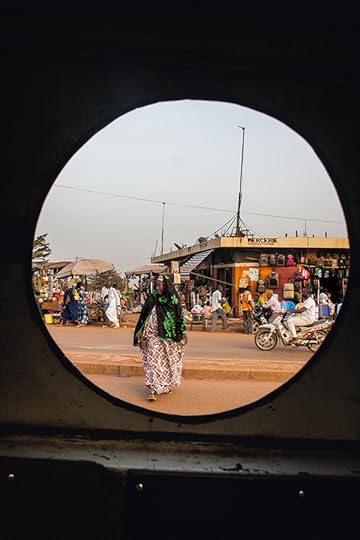
Amsatou Diallo, An elderly woman crossing a street in Bamako, 2016
Courtesy the artist
In the series Bamako—des fenêtres du Sotrama (Bamako–windows of Sotrama, 2016), Amsatou Diallo circulated for days in Sotramas, popular minivans, through the streets of Bamako. These vehicles are the city’s most frequently used means of transportation, allowing the majority of citizens to participate in broader city life. Through the differently shaped windows of the Sotramas, Diallo immortalized hundreds of small scenes of unspectacular urban life from the outskirts of Bamako to the city center: an elderly woman crossing the street, a small mosque with its speakers attached to the minaret, posters of the last elections hanging on a pole. By framing public urban space through these windows, Diallo highlights and celebrates scenes from everyday life. Many practices repeat themselves in small variations throughout a day. By doing so, they bring ordinary city life into being. The assembled incidental scenes suddenly reveal a bigger picture of the city.
While Diallo’s photographs explore Bamako during the daytime, Mamadou Sekou Kone’s Le silence de la ville (The silence of the city, 2016) explores Bamako by motorcycle late at night. His photographs reveal another side of the city, seen without its inhabitants, when citizens have withdrawn into private places and the public space presents itself as quiet, stark, and empty. Electric light reduces the view, bringing more static elements of the urban space to the fore: streets, bridges, and traffic signs emerge sharply under the streetlights; illuminated billboards, huge trees, and monuments loom out of the darkness. The black-and-white photographs are reminiscent of film stills. Their apparent timelessness dignifies the city, and, in the dreamlike state of night, boundaries and shapes blur, presenting a sense of placelessness.
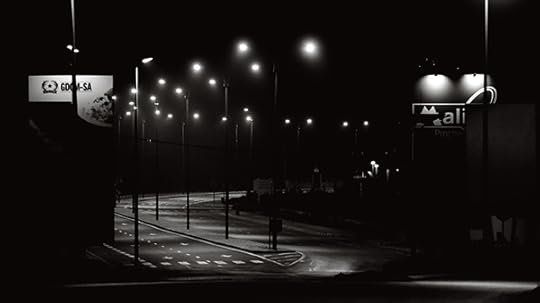
Mamadou Sekou Kone, Bamako by night, 2016
Courtesy the artist
Highlighting an individual, personal level of experience in the city, Oumou Traore’s series Deux soeurs à Bamako (Two sisters in Bamako, 2016) focuses on the lives of two sisters who emigrated from the Dogon country to the capital to work as domestic servants. This subject resonates with Traore’s own immigrant experience of working as a servant to earn money to pay for her basic expenses, and the costs necessary for becoming a photographer. Her intimate portrayals of the lives of the two new arrivals unfold, from the inside and the private to the outside and the public. She follows the sisters from dawn to dusk, sensitively capturing the labor-intensive routine of the two domestic workers and highlighting the invisible roles they play in Bamako’s city life.
In the last few years, the unprecedented growth of Bamako has brought with it highly questionable practices of urban land management, where the powerful and rich often win out over the poor. Aboubacar Traore is a constant observer of the city’s evolving landscape. Between 2009 and 2014, for his series La porte de l’enfer (The gates of hell), he documented the demolition of houses and the expulsion of their inhabitants. In one image, the remnants of a family’s house can be seen days after its destruction, executed by goons who were acting under police supervision. Most of the family members had left to find temporary shelter with relatives. Traore’s photographs show an unsettling discrepancy between the destroyed infrastructure and the effort of three remaining sons who continue everyday life in the ruins, not giving up on their rights. The series reveals how some citizens in Bamako cope with constant uncertainty, where from one day to another everything can change and usually does.
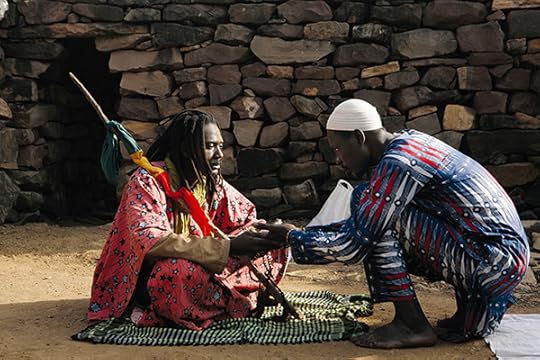
Seydou Camara, One of the sons of the late El Hadji Soufi Adama Yalcouye receives a worshiper in their mosque, which was built in the midst of the Niger’s riverbed, 2016
Courtesy the artist
As a participant in the Photographers’ Master Class, initiated by the Goethe-Institut Johannesburg and curator Simon Njami, Seydou Camara traveled to Khartoum, Sudan, in 2016. The class provided him with the opportunity to reactivate his long-term project Les Soufis (The Sufis), started in 2012, which looks at Sufi practices and how they are performed across Africa. Camara’s work delivers a careful and nuanced picture of Islam, with emphasis on the religion’s peaceful aspects. During his stay in Khartoum, he photographed dervishes who gathered at a cemetery to pray for their sheikh. Back in Bamako, Camara turned his lens toward Malian practices of Sufism, portraying the everyday lives of the followers of the late El Hadji Soufi Adama Yalcouye. Adama did not belong to an established Sufi brotherhood; rather, he practiced a fusion of Islam, Christianity, Dogon, and Bamana religious beliefs. Camara’s pictures illustrate the diversity, complexity, and liveliness of Sufism in Africa.

Fatoumata Diabate, Untitled, Somone, Senegal, 2013, from the series Studio Photo de la Rue
Courtesy the artist
Mali’s famous studio tradition, however, continues to influence younger generations. In her project Studio Photo de la Rue (Studio photo from the street, 2013–ongoing), Fatoumata Diabate reenacts the famous Malian photography studios of the 1950s and ’60s. Inspired by the works of her Malian predecessors, including Seydou Keïta, Malick Sidibé, and Youssouf Sogodogo, but also the Cameroonian, Central African Republic–based artist Samuel Fosso, Diabate created a mobile studio, which she has installed in Bamako, as well as in the French cities of Arles and Montpellier. Clients entering this nostalgic studio are encouraged to choose props and clothes, pose in front of a textile backdrop, and spontaneously slip into other identities. The studio is a stage-like, open-air installation where the whole process becomes a performance. The final portraits create something of a playful time lag: Diabate’s twenty-first-century clients enter her small time machine, which transports them back to the golden age of studio photography in Bamako.
Franziska Jenni is a PhD candidate in the Department of Social Anthropology at the University of Basel.
This article is part of a series produced in collaboration with Contemporary And (C&) – Platform for International Art from African Perspectives.
Read more from Aperture Issue 227, “Platform Africa,” or subscribe to Aperture and never miss an issue.
The post Through the Lens appeared first on Aperture Foundation NY.
Between Two Worlds
In poetic, politically charged images and videos, Zineb Sedira confronts the recent history of North Africa.
By Coline Milliard
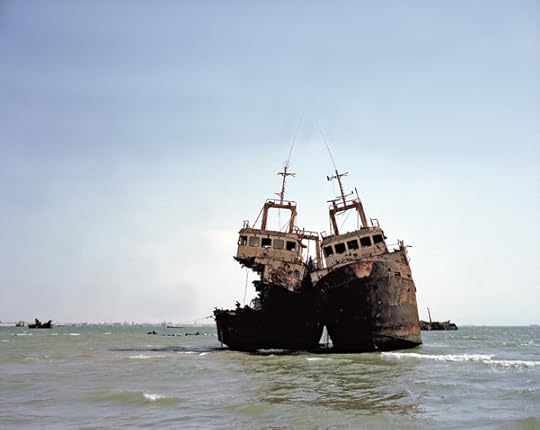
Zineb Sedira, The Lovers, 2008
© the artist/DACS, London and courtesy kamel mennour, Paris/London
Zineb Sedira is perhaps the contemporary artist most closely associated with Algeria. In the last two decades, she has become a prominent champion of the North African country of her parents’ birth—both in her work and as a host. In 2011, she turned a flat in Algiers into a base for aria, an international artist residency program. Sedira’s multiple identities, as a French Algerian woman and mother based in London, served as the springboard for a practice that initially focused on video and photography. From this deeply personal perspective, she has addressed topics ranging from her relationship to cultural signifiers such as the veil (Silent Sight, 2000), to intergenerational communication in a Diaspora context (Mother Tongue, 2002), and her family’s traumatic experience of the Independence War (Retelling Histories, ma mother told me, 2003).
But Sedira isn’t one to limit or repeat herself. Over the years, she has widened the paths she set out to explore, both geographically and thematically. Autobiography gave way to a poetic but politically charged investigation of global fluxes—of people, of goods—in which the sea plays a central role. Sedira also turned her lens to those whom history and the media have left behind. In her video Gardiennes d’images (2010), there’s Safia, the widow of Mohamed Kouaci—the only Algerian photographer known to have documented the Independence process—who is now left with the daunting task of looking after a sprawling photographic archive. In Floating Coffins (2009), there are those men and women who live in and around the shipwrecks and abandoned containers in Nouadhibou, Mauritania, many hoping for passage to Europe.
Sedira’s formal vocabulary has also grown in ambition and scope. Her videos have split and multiplied in immersive installations; photographs have taken a sculptural turn with freestanding light boxes; objects have cropped up. In the midst of an intense production period ahead of solo shows at the Sharjah Art Foundation in 2018 and the Jeu de Paume in Paris in 2019, I sat down with Sedira in her Brixton studio to discuss her trajectory and the projects ahead.
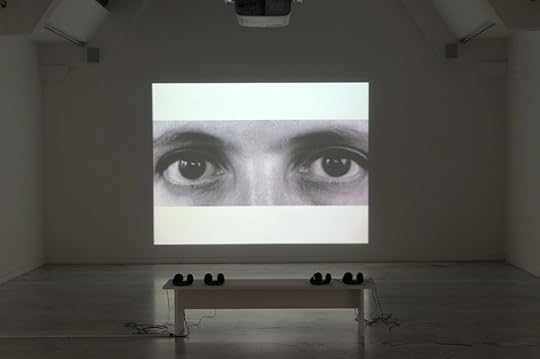
Zineb Sedira, Silent Sight, 2000. Video projection, 11 minutes, 10 seconds, black and white, sound
© the artist/DACS, London and courtesy kamel mennour, Paris/London
Coline Milliard: Let’s start with your upcoming exhibition at the Sharjah Art Foundation, which will open in March 2018. One of the new pieces focuses on the route of the first Indian service by Imperial Airways (now British Airways), which linked London to Karachi via Sharjah, U.A.E. How did this project come about?
Zineb Sedira: Much of my work deals with the idea of mobility—whether by plane, train, or boat. While doing preliminary research in Sharjah, I came across the Al Mahatta Museum, which was the U.A.E.’s first airport, originally built in 1932. At the time, the planes travelling to Sharjah from London came from Croydon Airport, which, after closing in 1959, also became a museum. This was the perfect project because it meant that I would be doing research in the archives in Sharjah and at the Croydon Airport Society. Looking at the journey, there have been many changes in terms of stopovers and in terms of airports. Some don’t exist anymore or their names have changed. And some countries shifted: Palestine has become Israel; Karachi, India, is now in Pakistan. In the 1930s, Britain was so powerful that it could decide where to set up airports in other countries. Travel was easy because of the deals Britain had with local authorities within the Empire.
Milliard: Besides your archival research, you’re also going to travel the route physically. Why was it important to put yourself in the shoes of these former passengers?
Sedira: In 1932, most of the passengers were wealthy, mostly male, Westerners. I will take that journey as a woman of Arab background. I will try to keep the same path because I want to highlight the difficulty of recreating that route eighty-five years later, and the new geo-political map. Now each country has its own airline. Visas are slowing the process down and there are places where I might not be able to go at all. In each location, I will dress in the style of the 1930s to add a jarring time-lapse to the images that will come out of the project.
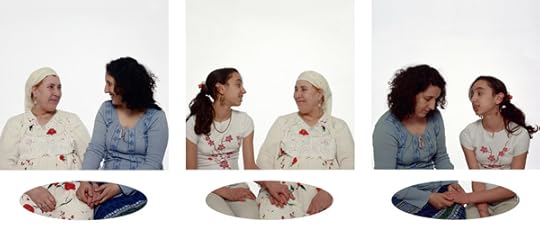
Zineb Sedira, Mother, Daughter and I, 2003
© the artist/DACS, London and courtesy kamel mennour, Paris/London
Milliard: This is an interesting shift in your practice. Your early work featured yourself heavily, but always as a witness, or as an interviewer of your family, without any artifice. Here, you’re using yourself almost like you would use an actress. How do you see this transition?
Sedira: Being physically implicated in the project, portraying myself in it, and dressing in the style of the 1930s will allow me to better understand what it meant to take these journeys. It is also a creative and visual choice. I like challenging myself, hence why I’m not doing a film or a traditional photography project. The final piece will be an installation, where photography has a large presence, but there will also be objects and archival material.
Milliard: Your oeuvre starts with self-representation, for example, in your series from 2000, Self Portraits or The Virgin Mary. What was the original impulse to put yourself in front of the camera?
Sedira: The idea of performing. I did a lot of reenactment of rituals, where you might not see me fully, but you’d see my hands, my mouth, or my eyes. That was born from the feminist movement of the 1970s—a reaction to the male gaze on the female body. A strategy for me was to fragment the body. When I became a mother in the early ’90s, I put myself fully in the picture, but my mother and daughter were there, too. It became a family affair.
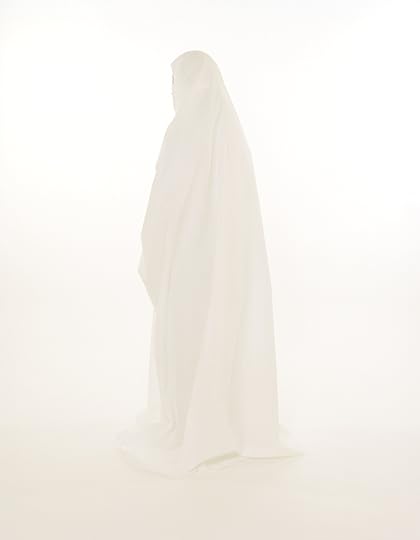
Zineb Sedira, Self Portraits or The Virgin Mary, 2000
© the artist/DACS, London and courtesy kamel mennour, Paris/London
Milliard: In 2002, you went back to Algeria for the first time after La décennie noire, or the Dark Decade, years of terrorism that tore the country apart between 1991 and 2002. From then on, you were able to create a new relationship with a country you only knew from your childhood and teenage years. This coincides with a clear shift in your work, which went from a very personal perspective to something which has become much more universal. Is it fair to say that the experience of going back was a trigger for that change?
Sedira: Before 2002, I had been working with oral history and my parents’ stories about Algeria. I was making work based on my memory and what it meant to be Algerian in France, specifically in the suburbs of Paris. In 2002–3, I was invited to the French Institute in Algiers for an exhibition in collaboration with a local gallery, Galerie Esma. I got to spend time in Algiers and totally fell in love with it. Then, in 2006, thanks to a commission from the Photographers’ Gallery and the Film and Video Umbrella in London, another important shift happened: I worked with a film crew and actors for the first time on what was to become my piece Saphir. I moved away from the autobiographical and started working with the landscape of Algeria.

Zineb Sedira, Saphir, 2006. Video installation. Double projection, color, sound
© the artist/DACS, London and courtesy kamel mennour, Paris/London
Milliard: Saphir is also remarkable in the way it introduces a very poetic imaginary. More generally, what place do you give to fiction in your work?
Sedira: Fiction is important, but it always starts from the personal. I need to hear or fall in love with a story. The work is often anchored in my French-Algerian-English experience—but when I use fiction the context broadens, it becomes more universal. Opening up my work has been a constant preoccupation. I know Algeria well, and it is now very easy for me to work in Algiers, but for my own development as an artist, I need to explore other contexts. This is why I shot a ship graveyard in Nouadhibou, Mauritania, in 2008. This resulted in the video installation Floating Coffins (2009) and several photographic series (including The Lovers, 2008; The Death of a Journey, 2008; and Maritime Nonsense and Other Aquatic Tales, 2009).
Milliard: Floating Coffins is also part of a history of shifts. Each big piece that you make brings with it a whole new visual vocabulary. In this piece, there are fourteen screens, exposed cables. You really pushed the installation format. You also pushed the relationship between film and still image.
Sedira: My main medium is film and video, whether HD, 16mm, or more recently 35mm. But photography is always there, especially when traveling to shoot a film. I always come back with a large body of photographs. Photography is also often a medium I can control better than moving image because it’s easier to manage and less costly. Film requires a crew, a sound recorder, an assistant, etc. Photography only requires either one photographer, if the shoot is particularly technical, or simply me behind the camera.

Zineb Sedira, Shattered Carcasses, 2008. Installation of 10 light boxes
© the artist/DACS, London and courtesy kamel mennour, Paris/London
Milliard: Nouadhibou is known as one of the places where people leave Africa for Europe. This renders Floating Coffins particularly striking from the perspective of 2017, with the migrant crisis, which over the last few years has become so present in the news. Do you look back on your work? How do the layers of meaning evolve as current affairs change?
Sedira: Clandestine immigration has existed for a long time. In Algeria, we grew up with it. For the last thirty years, many young men in Morocco, Algeria, and Tunisia have been trying to leave for Europe by crossing the Mediterranean. We call them Harraga, those who burn borders. Much of my work has been based on this migration, as well as the immigration of my parents to France by boat in the early ’60s. More recently, we’ve heard lots in the news about immigration because of the crisis in Syria. Was I ahead of my time? No, it is just that immigration was just not portrayed on TV and in the press at the same scale.

Zineb Sedira, Gardiennes d’images, 2010. Double projection video, installation view
© the artist/DACS, London and courtesy kamel mennour, Paris/London
Milliard: In Sharjah, you’ll also show another body of work, which deals with a very topical subject, namely the freedom of press. Laughter in Hell (working title) tackles this theme in the context of terrorism in Algeria in the 1990s, and you’ve chosen to look at it from a very specific angle: caricature and humor. Why this perspective?
Sedira: In 2010, I did a project about the archive of the Algerian photographer Mohammed Kouaci (Gardiennes d’images), which led me to become interested in how art is used as a tool of resistance. But before that, during my many trips to Algeria, I spent time socializing with friends in bars or at dinners and we would always crack jokes. Eighty percent of their jokes were about terrorism in the 1990s. So, following my interest in oral history and art and resistance, I started collecting verbal jokes. But I quickly discovered that you couldn’t look at verbal jokes without exploring caricatures in the Algerian press, which developed rapidly at that time. I believe that this form of humor was developed to combat fear and death by poking fun at the terrorists and at the government. It was a release mechanism, as well as a communication tool to disseminate the political events of the time.

Zineb Sedira, Still from Gardiennes d’images, 2010
© the artist/DACS, London and courtesy kamel mennour, Paris/London
Milliard: The cartoonists were taking huge risks that they might become targets themselves.
Sedira: They were. On October 5, 1988, Algeria saw a revolution similar to the Arab Spring. Youngsters went into the street protesting against social injustice. They were shot brutally by the government of the time. A new government was formed and it authorized a private press. This decision led to the creation of countless newspapers in both Arabic and French, and they were benefiting from a freedom of speech never seen before. Some journalists, but also youngsters who hadn’t been involved in media before, became acute political caricaturists and virulent critics of terrorism. The terrorist motto was, “Those who fight us by the pen will perish by the blade,” so the journalists and caricaturists were directly targeted. Some died, others fled to other countries, mainly France.
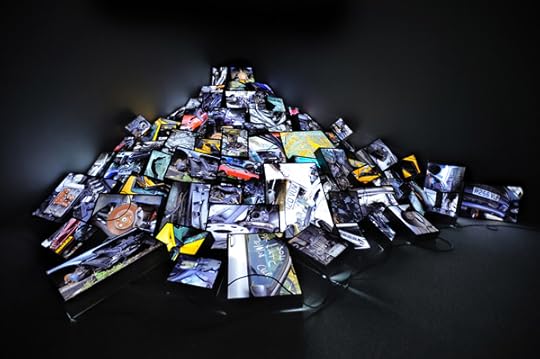
Zined Sedira, Dead End, 2010. Installation. 100 light boxes, electric cables
© the artist/DACS, London and courtesy kamel mennour, Paris/London
Milliard: While you were working on this piece, the attack on the French satirical newspaper Charlie Hebdo happened in Paris, on January 7, 2015. Did this have an impact on the way you were looking at your caricature project? Or did that make it more difficult to show?
Sedira: Yes, it was more difficult to show it. The project was meant to be exhibited in Paris in 2015, after almost ten years of research. But in the end, I was told it couldn’t be shown because the Charlie Hebdo events were too fresh and raw and curators were worried about a possible confusion between terrorism and Islam. In Laughter in Hell, I’m just displaying and sharing what happened in Algeria in the 1990s. Much of it was a criticism of terrorism and how the Algerian government dealt with it. Some people thought the Muslim community would be hurt by the project; others were worried about terrorists possibly harming me. Now I’m showing this project at the Sharjah Art Foundation, which financed its production. Sharjah is also fighting terrorism so the project is relevant to their context, too.

Zineb Sedira, Saphir, 2006. Video installation. Double projection, color, sound
© the artist/DACS, London and courtesy kamel mennour, Paris/London
Milliard: It’s interesting that you talk about the reaction in France because some of the topics that you’ve dealt with—and in particular the Independence War in Algeria—are very close to the bone there. The country has a particularly difficult relationship to its colonial past, mired in collective amnesia and denial. You’ve confronted it your entire career. Do you think things are changing?
Sedira: Sometimes it feels like we take one step forward, and then two steps back. Since the terrorist attacks in Paris, there has been a regression in the way French Algerian relationships are perceived, especially since some of these attacks were carried out by French Algerians (or French Moroccans). France has no real interest in looking at why this is happening. Why might a French Algerian not see himself as French? The conversations around these issues have been ongoing and are complicated. Until 1999, French history books said that the Algerian War was an “event,” and not a war. It is still believed by a certain political class that colonization was beneficial for Algeria, which is now ungrateful for the advantages it brought. Resentment often results from these types of views, and this creates problems in the French Algerian identities. Obviously, this is not a reason to become a terrorist, but there is still a problem in France with Islam at large, and especially with Algeria because of their shared history.

Zineb Sedira, And the road goes on…, 2005. Video projection, 8 minutes, 8 seconds, color, sound
© the artist / DACS, London and courtesy kamel mennour, Paris/London
Milliard: In 2011, you started aria, or Artist Residency in Algeria. This formalized something that you were already doing: inviting artists to spend time in Algiers to make work and meet people. Why was it important for you to become an actor in the Algerian art scene?
Sedira: Many people want to visit Algeria because they’ve heard of its colonial history, its architecture, its wealth in Roman ruins … but they don’t dare to go. When I had access to a flat in 2005, I was able to invite people: artists, friends, art critics, academics. I realized there was a considerable demand, especially from artists who wanted to make work about post-colonial Algeria. In Algiers, at the art school, students have few opportunities to explore “non-conventional mediums,” such as photo and video, or to exhibit, or to meet other artists when they leave school. In 2005, when I got to know the art scene, all I heard from artists was: “We want to meet other artists.” Aria was my response: I invited international artists—Alfredo Jaar, Kapwani Kiwanga, Kader Benchama among others—to come to Algiers to develop their research. And when they were in town, I asked them to meet local artists, and either to give a talk, or to lead a workshop, or to look at portfolios. That was my way of addressing the needs of both international and local artists, and, at the same time, putting them in conversation.
Coline Milliard is a writer and editor based in London.
This article is part of a series produced in collaboration with Contemporary And (C&) – Platform for International Art from African Perspectives.
Read more from Aperture Issue 227, “Platform Africa,” or subscribe to Aperture and never miss an issue.
The post Between Two Worlds appeared first on Aperture Foundation NY.
June 14, 2017
Photographing the Body Electric
Sam Contis’s first photobook revels in the land, skin, and mythologies of the American West.
By Amanda Maddox
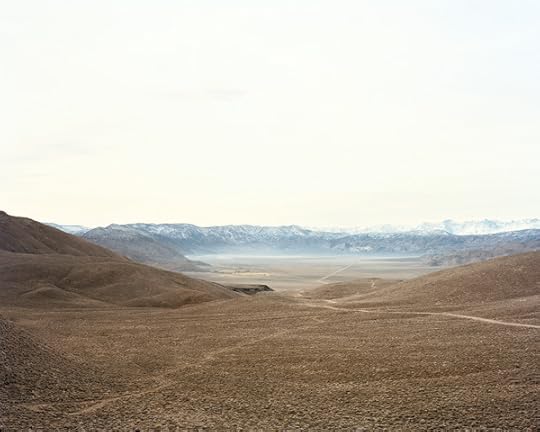
Sam Contis, Across the Valley (from Gilbert Pass), 2014
Courtesy the artist and Klaus von Nichtssagend Gallery, New York
People who come to California from somewhere else are often unprepared for this place. Wallace Stegner wrote of California that “perceptions trained in another climate and another landscape have to be modified” here, and we discover the need “to learn all over again how to see.” The photographer Sam Contis, originally from the East Coast, was compelled by the idea of recalibrating her vision of the American West through the lens of the Golden State—a dreamland defined by desert, drought, Hollywood films, heat, cowboys, freedom, reinvention, and open space.

Sam Contis, Arbor, 2014
Courtesy the artist and Klaus von Nichtssagend Gallery, New York
On a road trip in 2013, Contis found her way to Deep Springs, the name of both the valley and a remote liberal arts college nestled between the Inyo and White Mountains in the far-eastern part of the state. She recognized immediately how that specific landscape could shift her conception of the West and its mythology. Returning periodically over the course of four years, and collaborating with students, she created the series that became her first photobook, Deep Springs (2017), from a place that itself has perpetuated its own mythical status.
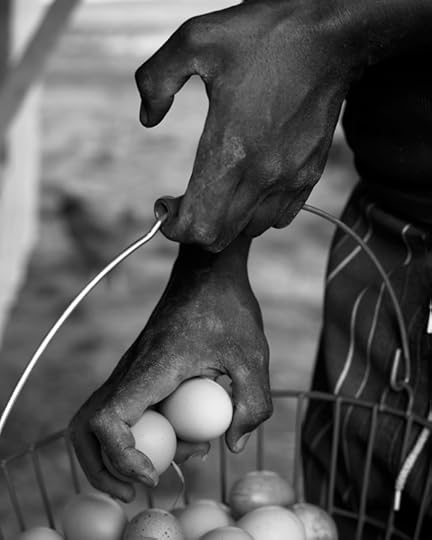
Sam Contis, Eggs, 2015
Courtesy the artist and Klaus von Nichtssagend Gallery, New York
Deep Springs College was founded in 1917 by L. L. Nunn. An electricity tycoon, Nunn was also a philanthropist who fashioned himself a “builder of men” by way of a college that would encourage students to develop “ideals of freedoms and lives of service.” For the last century, only the brightest young men have been admitted to study at Deep Springs. Coursework is balanced by manual labor: students maintain the ranch and farm on which the college is located, and they more or less govern themselves during their two years in residence. Into this masculine environment Contis inserted herself and established a temporary home while she explored the valley. The notion of a rugged, male-dominated western landscape loomed large and became her subject.

Sam Contis, Hold Down, 2014
Courtesy the artist and Klaus von Nichtssagend Gallery, New York
Students from Deep Springs feature prominently, albeit anonymously. Contis observed her young subjects as they wrestled, slept, rode horses, and matured. She was also an active participant who quietly entered a terrain marked by invasion, and interrogated the common mythologies of the West by offering a more personal, private vision. Acknowledging the long legacy of photographers inspired by California’s landscapes—William Henry Jackson, Timothy O’Sullivan, and Carleton Watkins—Contis presents the West as a place of exploration that is more intimate than distanced. Like the students of Deep Springs, Contis looks to the West—both the land and the people in it—as a source for defining one’s identity and sense of purpose.
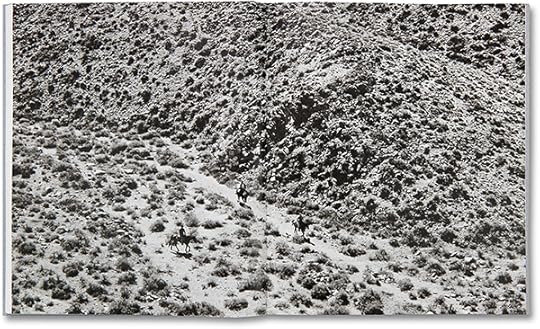
Spread from Deep Springs (London: MACK, 2017)
Courtesy the artist and MACK
In reverence to her artistic forebears, Contis began the project by utilizing a 4-by-5-inch plate camera. One reason she refers to the project as a collaboration is her choice of equipment: occasionally she would ask the young men to repeat a motion or gesture, simply because she couldn’t reload film fast enough. But she also relished the opportunity to update the prevailing nineteenth-century photographic portrayal of the isolated, stationary, sepia-toned western landscape, using digital technology and color film to inject motion and life.
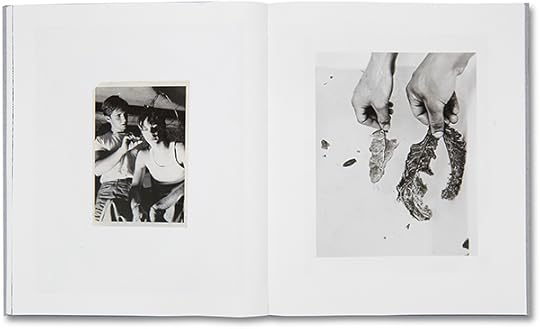
Spread from Deep Springs (London: MACK, 2017)
Courtesy the artist and MACK
Deep Springs reveals a preoccupation with skin and flesh, beginning with the cover of the book: a photograph depicting the lithe curve of a muscular, indented back is printed directly on the grey paper that envelops the cover cardstock. Skin pressed up against skin. (And, in perhaps a subtle nod to the physical terrain of Deep Springs, the cover itself comes to resemble granite, which abounds in the valley.) Opening the book reveals the soft pink end paper; lifting this outer layer, we enter the flesh of the narrative.
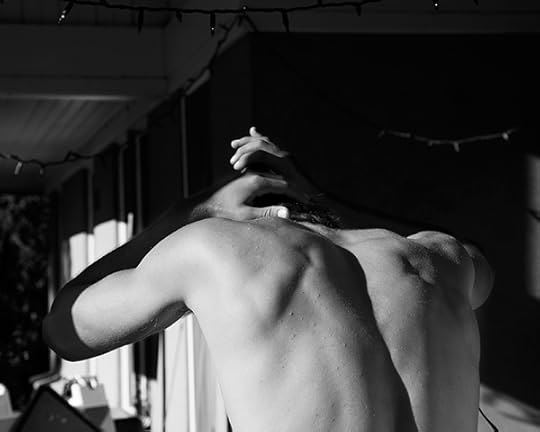
Sam Contis, Close Cut, 2013
Courtesy the artist and Klaus von Nichtssagend Gallery, New York
Contis often focuses on the bodies of her subjects—virile, sinuous, sometimes indeterminate—and shows the strength and softness that these young men embody simultaneously. Walt Whitman’s poem I Sing the Body Electric resonates here, both for the beauty of human forms registered in the images and the allusion to Nunn’s profession, which serviced the creation of the college. In Deep Springs, tender close-ups reveal the gentle crook of an elbow, the grooves in a neck, the lines of a hand. They celebrate Whitman’s lyric: “To see him pass conveys as much as the best poem, perhaps more, / You linger to see his back, and the back of his neck and shoulder-side,” forming a visual poem of their own. The careful sequencing of images—with a selection that incorporates pictures made by some of the first students at Deep Springs, which Contis unearthed in the college library—reverberate between past and present. Photographs occasionally cross the gutter like an enjambment, or step across the pages like notes on sheet music, resembling the kind of triadic rhythm found in the work of William Carlos Williams. To invoke Whitman again, here is a book that encapsulates the phrase “your very flesh shall be a great poem.”

Sam Contis, High Noon, 2014
Courtesy the artist and Klaus von Nichtssagend Gallery, New York
Deep Springs allowed Contis to defy tradition as much as honor it. The project provided the space, and the freedom, as she says, to “let go of the idea that work needs to be made in one format.” She could resist or embrace speed. She could capture the infinite horizon, or study textures as delicate as dust and tallow. In other words, just as fault lines spread out like subterranean highways below the sun-bleached terrain of California, Contis’s notions about photography began to fissure and crack open. Perhaps for Contis, who now calls California her home, there may be some truth, as Stegner once wrote, that “the West is less a place than a process.”
Amanda Maddox is assistant curator in the Department of Photographs at the J. Paul Getty Museum.
Deep Springs was published by MACK in 2017. Sam Contis: Deep Springs is on view at Klaus von Nichtssagend Gallery, New York, through June 18, 2017, and Sam Contis / MATRIX 266 is on view at the University of California, Berkeley Art Museum and Pacific Film Archive until August 27, 2017.
The post Photographing the Body Electric appeared first on Aperture Foundation NY.
June 13, 2017
Marie Cosindas (1923–2017)
Aperture remembers the life of Marie Cosindas, pioneer of the painterly color photograph, who died on May 25.
By Lisa Hostetler

Marie Cosindas, Princess with Doves, 1966
© the artist and courtesy Bruce Silverstein Gallery, New York and Amon Carter Museum, Fort Worth
Marie Cosindas made a big splash in 1966. That was the year that a solo exhibition of her color photographs opened at the Museum of Modern Art in New York and then traveled to the Museum of Fine Arts, Boston, and to the Art Institute of Chicago the following year. In the catalog, John Szarkowski wrote that her photographs were “as Marianne Moore said poems should be—imaginary gardens with real toads in them.” The exhibitions brought her considerable recognition, and her work was published throughout the 1960s and ’70 s in a diverse range of magazines, from Camera and Aperture to Ladies’ Home Journal and Newsweek. Life featured her work four times between 1968 and 1976, and in his introduction to the 1978 monograph Marie Cosindas: Color Photographs, novelist Tom Wolfe—who had been one of her portrait subjects—noted, “By 1968 she was one of the best-known photographers in the United States.” But her fame subsided in the 1980s, and today her place in the history of photography is often overlooked. Why? Perhaps it is because her work has always been an anomaly.
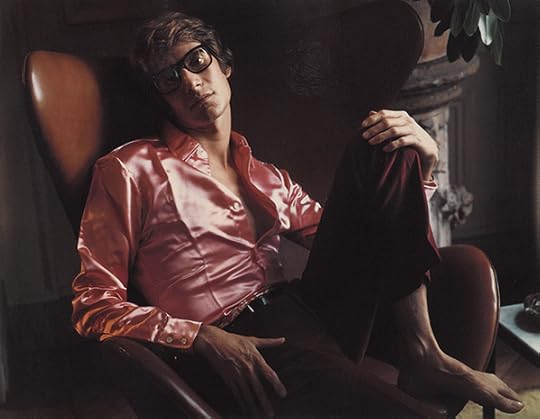
Marie Cosindas, Yves Saint Laurent, Paris, 1968
© the artist and courtesy Bruce Silverstein Gallery, New York and Amon Carter Museum, Fort Worth
Cosindas’s portraits were known for their warmth and intimacy, and her still lifes suggested an air of reminiscence suffused with mystery. This, at a time when Pop Art’s brightly colored irony and Minimalism’s intellectual rigor pervaded the art world, separated her from prevailing trends. In addition, the most common adjective applied to her photographs at the time they emerged was “painterly,” a characterization that could be construed as a backhanded compliment, depending on who uttered it. Coming from someone who struggled with the notion of photography as an art form—and this could be an art historian, curator, critic, or collector as easily as it could be a member of the general public—the term was an accolade, indicating that Cosindas’s photographs were successful as works of art. In this respect, it is telling that most writers commenting on her photographs took pains to recount her carefully arranged compositions and color schemes, her use of filters to control the quality of light, and the adjustments she made to room temperature, exposure, and development times in order to affect the chemistry of the Polacolor film. It is as though writers felt compelled to compensate for Cosindas’s choice of medium, and perhaps they did, for in the 1960s color photography was most commonly associated with commercial or amateur photography, and instant photography with snapshots and test images.

Marie Cosindas, Asparagus 1, 1967
© the artist and courtesy Bruce Silverstein Gallery, New York and Amon Carter Museum, Fort Worth
When applied to Cosindas’s photographs by others, however, the term “painterly” was less complimentary, suggesting that the work attempted to conceal its true photographic essence. For such commentators, Cosindas’s choice of instant color photography was something to be celebrated, but her subject matter was problematic: famous dandies, frilly dolls, and exotic masks were not the stuff of everyday life, and photography should devote itself to documenting ordinary scenes in situ if it wanted to put its best foot forward. The canonization of William Eggleston and Stephen Shore in the 1980s reified this point of view. Seen as a hybrid of Pop and Conceptual art that did not undermine the Modernist edict to be “true to medium,” their deadpan snapshot aesthetic was more easily integrated into the art world (especially with Szarkowski as its champion). Recognizing this, Wolfe wrote, “Marie Cosindas’ work was like forbidden fruit unaccountably made available.” Now that the furor over color photographs as art has receded, it seems like a good time to take a bite.
Lisa Hostetler is coauthor of Color Rush: American Color Photography from Stieglitz to Sherman (Aperture, 2013) and the Curator-in-Charge in the Department of Photography at the The George Eastman Museum.
This essay originally appeared in Aperture Issue 213, “Photography as you don’t know it.”
The post Marie Cosindas (1923–2017) appeared first on Aperture Foundation NY.
June 8, 2017
Screen Legends
South Africa’s new media artists are transforming the digital world.
By Khanya Mashabela
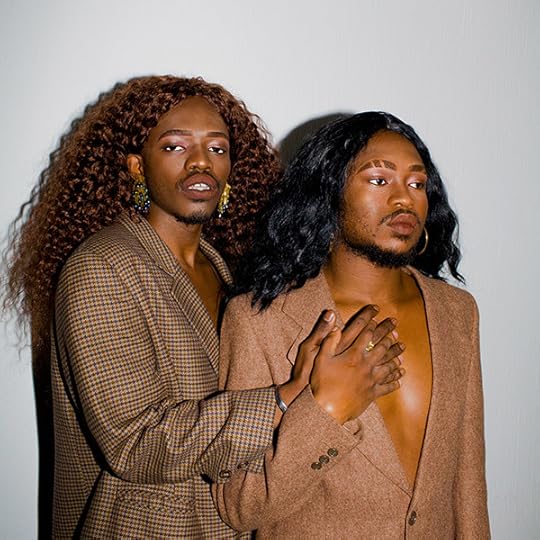
Amira Moraloki, FAKA, 2017
© and courtesy the artist and FAKA
Is the unending archive of visual references online more real than reality itself? In South Africa, Bogosi Sekhukhuni, CUSS Group, Tabita Rezaire, and FAKA are among the artists and art collectives working to reinterpret local realities and global visual cultures. By employing the aesthetic powers of online spaces, they create art that is enigmatic and nostalgic, ironic and socially conscious. But, notably, these artists are not confining their art to cyberspace; they are also exhibiting Internet-based work in galleries, museums, and biennials. By placing such art in traditional, physical venues of display, they are pushing viewers to create new tactics of engagement with pieces borne of online spaces.

Bogosi Sekhukhuni, Still from Simunye Systems Orientation, 2017. HD video, 7:23 minutes
© the artist and courtesy Stevenson Cape Town and Johannesburg
Bogosi Sekhukhuni’s Tumblr homepage is a GIF of the 1990s-era Canadian television program Animorphs. For South Africans in their twenties and thirties who were regular watchers of after-school cartoons screened by the South African Broadcasting Corporation, the reference is a nostalgic one. And while an example of the globalization of media, it is also illustrative of Sekhukhuni’s use of the hyperreal. Sekhukhuni creates his images, videos, and installations from a patchwork of references drawn from an array of similarly suggestive visual media, from local television ads to alien conspiracy videos. The user experience of his Tumblr contextualizes Sekhukhuni’s chosen media; for example, clicking on “feed” leads to YouTube videos with titles like “Avatar: The Last Hoodbender” or an interview with Lauryn Hill. These are mixed together with works by Sekhukhuni such as Orisha Totems (2016), previously displayed as large-scale hanging photo sheets at the 2nd Edition of the Kampala Biennale in Uganda. Onscreen, these triplicate portraits show the artist wearing light jeans and pastel T-shirts, photoshopped into imagined spaces of water, land, and sky that scroll as satisfyingly as a flip book. By interweaving original artwork with found footage, Sekhukhuni firmly places his practice within the aesthetic experience of the online space.
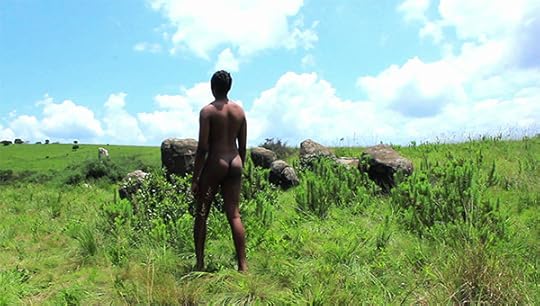
Bogosi Sekhukhuni, Still from Simunye Systems Orientation, 2017. HD video, 7:23 minutes
© the artist and courtesy Stevenson, Cape Town and Johannesburg
Clicking instead on “OPEN TIME COVEN” leads to a page with an autoplaying video of a faux archaeological site/installation artwork at the 2016 Dakar Biennale. The accompanying text is simultaneously artist’s statement, institutional critique, and New Age spirituality drawn from African sources, underscoring the predominant theme across Sekhukhuni’s practice: the reevaluation of narratives about South Africa, the African continent, and black people, globally. His artwork pushes against a linear narrative of art history in which the West is home to modernity and postmodernity and Africa is home to the prehistoric, as illustrated by “authentic” wooden curios and masks bought by tourists. By reshaping the past and critiquing the present, his work offers us a utopian future.
Sekhukhuni has also worked with CUSS Group (Ravi Govender, Zamani Xolo, Jamal Nxedlana, Christopher Bryden McMichael, and Lex Trickett), an artist collective that uses similar tactics in their online presence. A web page they made in 2016 used the visual language of online scammers to sell an undefined product from the “Triomf Factory Shop.” At the 9th Berlin Biennale, in a work titled Nguni Arts International (2016), they created a storefront for this mythical business, sparsely stocked with innocuous, self-branded goods such as a fragrance and beer. It served as a front for their backroom activities: a program of live performances, closed to the public, but streamed into the front room. The storefront and its program of performances were made in collaboration with South African artists ANGEL-HO, FAKA, Megan Mace, and NTU, a collective founded by self-proclaimed tech healers Sekhukhuni, Nolan Oswald Dennis, and Tabita Rezaire.
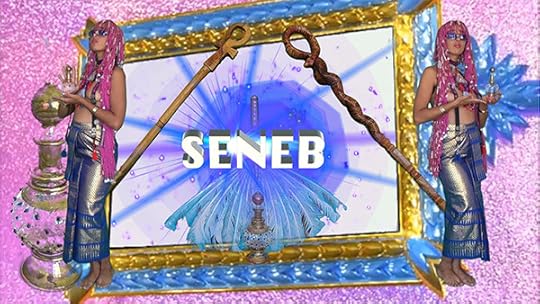
Tabita Rezaire, Still from Seneb, 2016. HD video, 7:30 minutes
© the artist and courtesy the Goodman Gallery, Johannesburg
Rezaire, a French Guianese Danish multimedia artist based in Johannesburg, also uses the Internet’s hyperreality as an artist’s tool. Her work shape-shifts as satire, educational lecture, and vaporwave music video. The wallpaper of her personal website is made up of screenshots contrasting Wikipedia entries of the words prophet (“not to be confused with Profit”) and profit (“not to be confused with Prophet”), in the center of which is an image of Rezaire sitting in the lotus position and dressed in a metallic spandex bodysuit. Every element of the site unsettles the perception of her work as either sincere or ironic, as it appears to mock itself while genuinely offering thoroughly argued strategies for healing and resistance against misogyny and racism, online and off.
The experience of watching the beginning of Rezaire’s video Hoetep Blessings (2016) is especially rooted in the online landscape: it makes use of an Urban Dictionary entry and Wikipedia to define the word hotep. While she gyrates to kitsch flute music in front of green-screen images of hieroglyphs and the Pyramids, Rezaire explains that hotep is an Egyptological term for htp, meaning “inner peace.” Hotep has been adapted by black communities to refer to men who position themselves as champions of black issues—men who would unironically use hotep as a greeting—while working to counteract black feminist and queer resistance with “traditional values.” Rezaire proposes that the word hotep be reclaimed. Her gyration functions as a feminist tool of this reclamation. Combined with numerology, Kiswahili etymology, chemistry, neurology, yoga, and ancestral knowledge, she instructs viewers how to go from “hotep to hoEtep”— how to resist and heal from regressive narratives about black female and queer sexuality by taking ownership of the digital landscape.
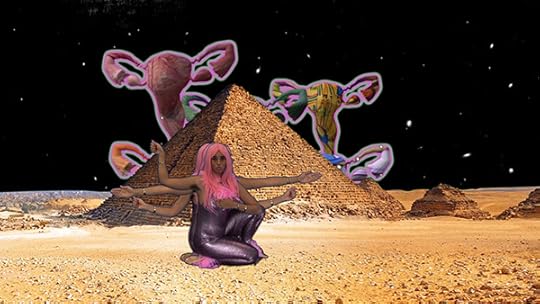
Tabita Rezaire, Still from Hoetep Blessings, 2016. HD video, 12:30 minutes
© the artist and courtesy the Goodman Gallery, Johannesburg
FAKA, an art duo formed by artists Thato Ramaisa and Buyani Duma, working under the alter egos Fela Gucci and Desire Marea, respectively, use visual culture on the Internet to reclaim the dialogues surrounding their race, sexuality, and class. As suggested by the name Fela Gucci, FAKA use a mash-up of African and Western references in the dress, music, and performance that appear in their videos. Riffing on pop-culture icons like Brenda Fassie and Bette Midler, they have become muses for and collaborators with photographers such as Musa N. Nxumalo, Kristin-Lee Moolman, and Jody Brand, and as well as the fashion and culture site Bubblegum Club.
FAKA’s video Isifundo Sokuqala (2016) is an assertive proclamation of their sexuality and physicality as queer black males. They writhe, dance, and pose wearing blond Afro wigs, gold chains, and elbow-length pink gloves in a house and neighborhood with all the markers of working-class South Africa. Set to a gqom soundtrack, a genre of music from the Durban underground house scene, Isifundo Sokuqala has the feel of a music video, and, in fact, is one, for a single of the same name on FAKA’s debut EP, BOTTOMS REVENGE (2016). Even so, the video’s aesthetic and its loose narrative make a strong statement, playing upon the homophobic discomfort of queer sexuality often found in South Africa. Working-class, queer South Africans are among the most severely affected by the country’s high rate of violent crime, due both to homophobia and their lack of access to the middle class’s high-walled security estates. As Sekhukhuni and Rezaire do with their multiplatform interventions, FAKA uses the online space to subvert hostile narratives through imagined realities and identity making.
The Internet “creates a metaphorical world in which we conduct our lives,” Mark Nunes wrote in a 1995 essay on Jean Baudrillard and cyberspace. “And the more ecstatic the promises of new, possible worlds, the more problematic the concept of ‘the world’ becomes.” Baudrillard himself theorized that a catastrophe would occur in the future when the sophistication of the simulation would surpass reality, “a hypertelic process in which we will have gone faster than our shadow.” Although we have not reached Baudrillard’s “catastrophic” phase, the placement artworks using the linguistic and visual conventions of the digital space into the physical world suggests that the hyperreal is in the process of surpassing the real.

Bogosi Sekhukhuni, Soul Contract Revocations; Dream Diary Season 2, Joyce, 2017
© the artist and courtesy Stevenson, Cape Town and Johannesburg
Sekhukhuni, Rezaire, and FAKA have taken the Internet’s world-building, identity-creating capacities and used them in exhibitions at galleries, museums, and biennials that offer opportunities for audience engagement. Traditional art spaces give orderliness and accessibility to works that may seem obscure in the chaos of the online world. As Lerato Bereng, an associate director at the Stevenson gallery, told me, “I love the Internet and its infinity, but I acknowledge that the visual language of a web-based art intervention can leave one feeling technologically inadequate. This is part of the beauty, challenging the manner in which art is viewed, engaged with, and consumed. Artists such as Bogosi Sekhukhuni, Tabita Rezaire, the CUSS Group, and FAKA are part of a generation that have punctured the fabric of form and challenged the function of physical space.”
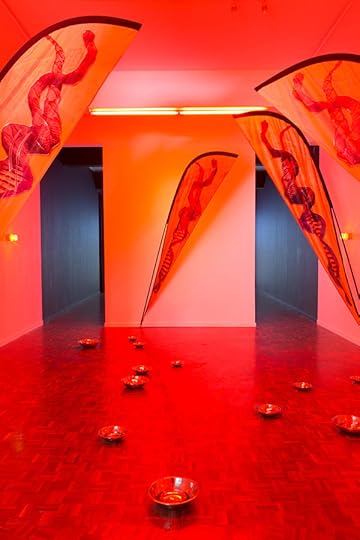
Bogosi Sekhukhuni, Simunye Summit 2010, 2017. Installation view at Stevenson, Johannesburg
© the artist and courtesy Stevenson, Cape Town and Johannesburg
Even so, through the use of installation art and live performance, these artists use traditional venues of display to offer an impactful physical element to viewers. Sekhukhuni’s latest solo exhibition, Simunye Summit 2010 (2017), included videos mounted on rainbow-colored headboards and made use of colored lighting and large-scale projection. Rezaire’s staging of a public “kemetic yoga” session in the exhibition space, and her placement of a video onto a physically evocative object—the gynecological examination chair—in her recent solo show Exotic Trade (2017) is another example. Live performance gives FAKA’s music and movements, as seen at their performance at the 9th Berlin Biennale, Rectum River (2016) described as “a four-part healing sermon,” an immediacy that cannot be reproduced in the digital realm.

Tabita Rezaire, Still from Deep Down Tidal, 2017. HD video, 19 minutes.
© the artist and courtesy the Goodman Gallery, Johannesburg
What happens when our cultural touchstones, created online, are translated and reframed in physical spaces? Traditional venues might offer their institutional approval and turn the user experience into something that is still visually and conceptually striking, and perhaps more easily intelligible to viewers. However, globally, we are living online with an intimacy that far exceeds our interaction with any one physical space. “With Instagram pages functioning as portfolios or spaces in which to stage visual activism, I see the ‘interwebs’ as an alternate reality to the gallery cube. I think the Internet is an incredibly expansive platform and cannot be used like galleries or museums but is a platform of its own neighborhood,” Bereng suggested. “Online exhibitions are successful when the versatility and expansiveness of the medium is acknowledged, explored and pushed, not in the way one would use a gallery space or traditional artist website.”
Though the Internet still leans heavily toward the Western center and is populated by the patriarchal and imperialist structures that dominate the real world, through it the implements of cultural production are more easily accessible. South African artists are using the Internet and its visual languages to create provocative statements that dismantle harmful ideologies and propose more representative utopias to take their place.
Khanya Mashabela is a freelance writer based in Cape Town.
This article is part of a series produced in collaboration with Contemporary And (C&) – Platform for International Art from African Perspectives.
Read more from Aperture Issue 227, “Platform Africa,” or subscribe to Aperture and never miss an issue.
The post Screen Legends appeared first on Aperture Foundation NY.
Aperture's Blog
- Aperture's profile
- 21 followers



